2 weeks, 11 national parks, 3,350 miles: Savor the Southwest on the Grand Circle road trip
There are 63 national parks in the United States, but at the start of 2023, I’d made it to only one.
So when my partner, Reanna, bought us tickets to see Big Thief and Lucinda Williams at Colorado’s Red Rocks Amphitheatre, we had an exciting (though surely unoriginal) idea: What if we made it a road trip?
As I began researching the best routes from Los Angeles to Denver, I found variations of what’s been called the Grand Circle road trip, a loop of national parks that typically spans Utah, Colorado and Arizona. It’s popular for its efficiency: If you plan well, you can hit the Southwest marvels of Zion, Mesa Verde and the Grand Canyon in about two weeks. Because we’d be driving through California regardless, our own Grand Circle route expanded into an oblong shape — not quite an oval, but perhaps a seal balancing a ball on its nose.
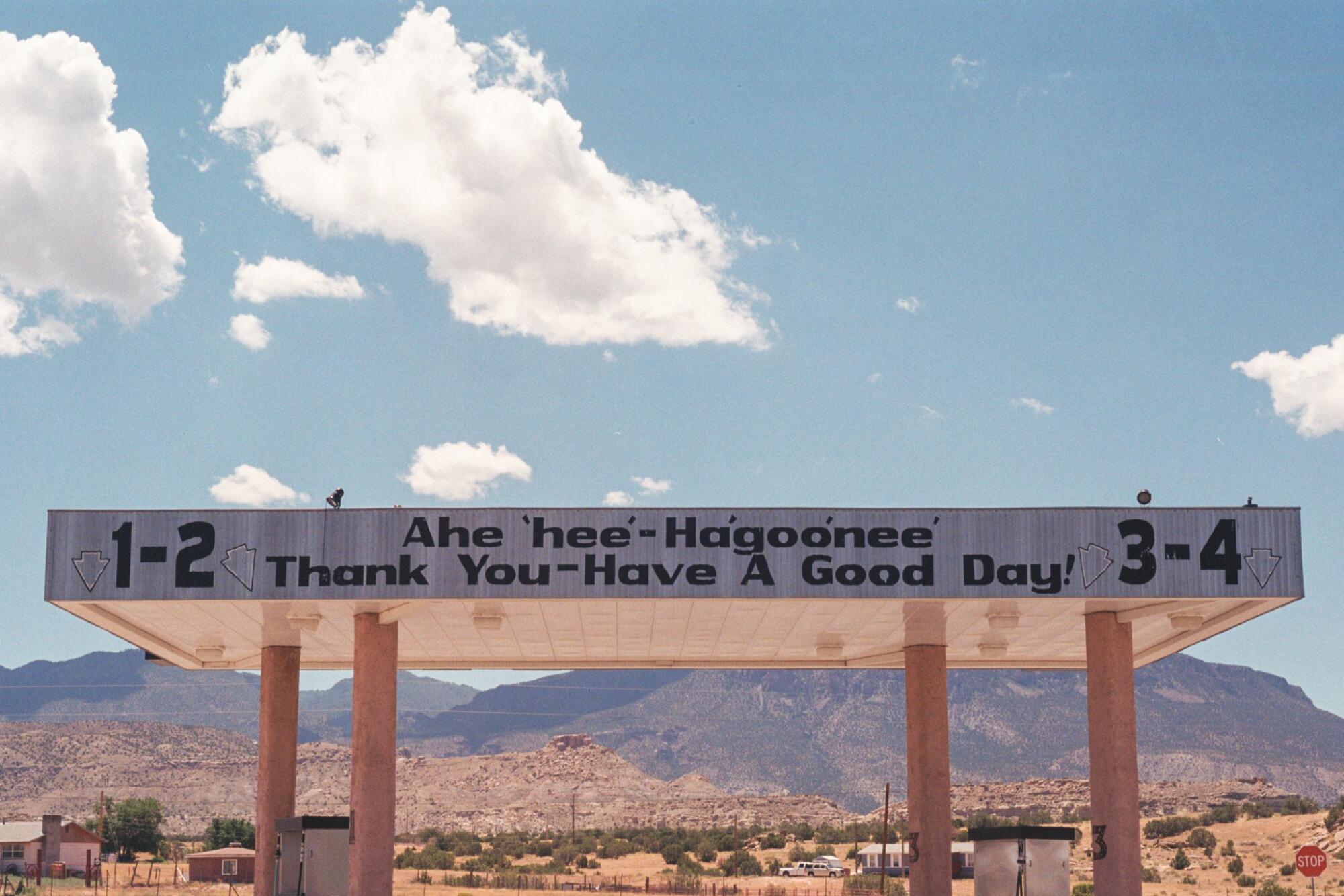
A canopy above the gas pumps at Arizona’s Teec Nos Pos Trading Post near the Four Corners Monument.
(Reanna Cruz)
Over the course of 12 days, we were able to fit in nearly a dozen national parks, 3,350 miles of driving, thousands of photos and a shameful amount of roadside hamburgers. (For scale, that distance is similar to driving from L.A.’s Santa Monica Pier to the easternmost point of the contiguous U.S. in Lubec, Maine.)
We would’ve happily spent an extra day in each place to break up the driving, as the quick pace of our trip made us feel absolutely loopy during the last few days when we spent hours in the car forcibly listening to every radio station play the Luke Combs version of Tracy Chapman’s “Fast Car.”
This is an exhaustive recap of our 300-or-so hours on the road, chock-full of small joys, roadside eats and things we should’ve planned better. (If you’d rather just cut to the chase and see the route we took click here. )
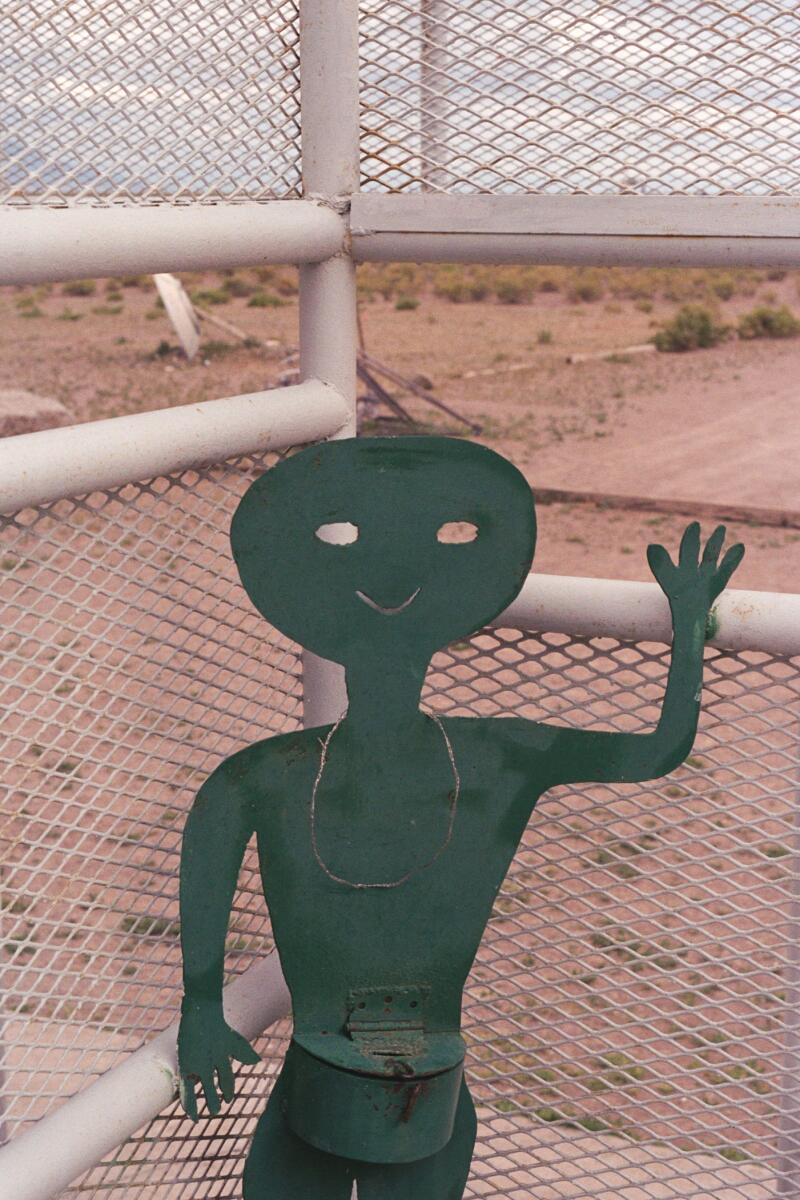
A new alien friend welcoming us to the UFO Watchtower in Colorado. (Reanna Cruz)
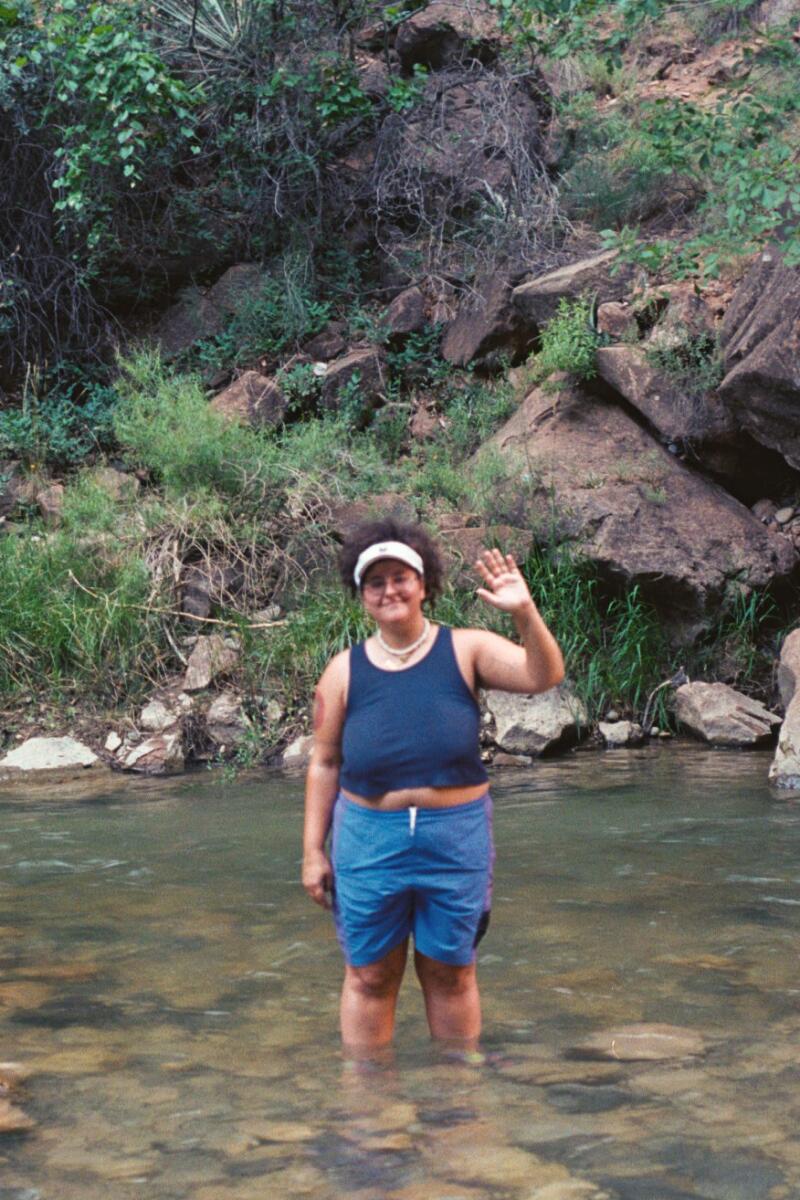
Reanna Cruz wading in the Virgin River at Zion National Park. (Julia Carmel / Los Angeles Times)
To make your own trip as smooth as possible, here are a few crucial tips:
- Buy the America the Beautiful National Park Pass. It costs $80 for the year, and visiting all these national parks would’ve cost us $325 in individual fees.
- Write down essential addresses in advance. Some of these roads (and nearly all of these national parks) have spotty cell service, and you can’t ask for directions if you don’t know where you’re going.
- Bring along a cooler and (at least) one case of bottled water. Hopefully you’re not doing this trip during the peak of summer heat like we did, but it’s vital to have extra water with you in the more remote areas of this trip.
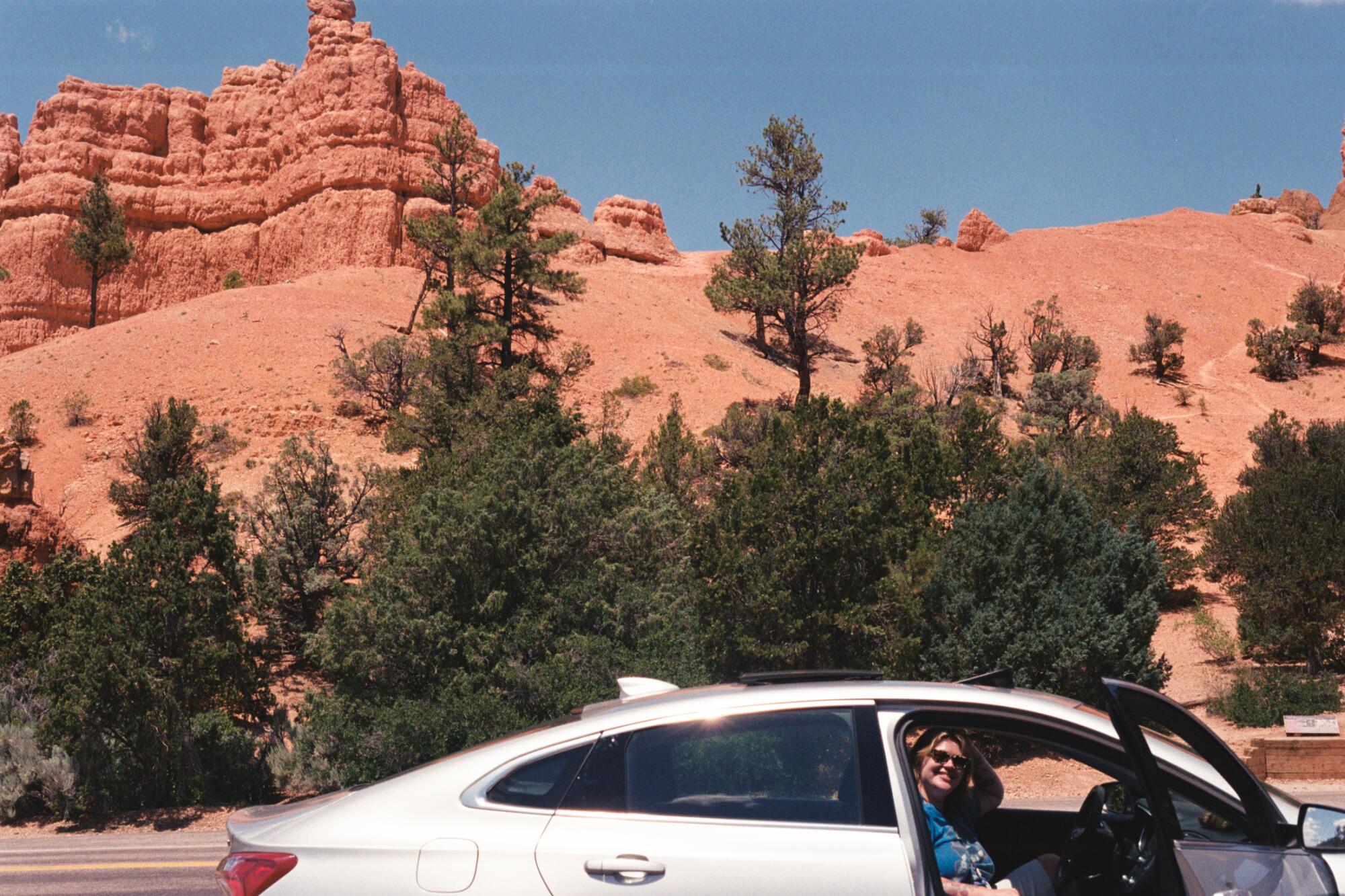
Julia driving through Bryce Canyon National Park on the Grand Circle road trip.
(Reanna Cruz)
Off to a rocky start
After loading up my car and filling the gas tank, we found ourselves waiting for a tow truck by the Getty Center, just seven miles into our ambitious journey.
My beloved car Marshmallow had broken down on the 405, and though that would’ve sucked on a normal day, it was especially upsetting at the start of a huge road trip. But after crying, calling AAA, my mechanic and my editor, and then looking up rental cars with the help of my wonderful co-worker Chris, we decided it was too late to call it quits.
After picking up a rental, we agreed that heading to Death Valley — where it was 116 degrees — was probably not worth the extra hours on the road. Instead, we made up for lost time by driving straight to Las Vegas, with one bathroom break at EddieWorld.
Our first night on the road was spent at the Venetian in Las Vegas, not because we needed to see a Cirque du Soleil show and people-watch at the local Taco Bell Cantina, but because Vegas is only two hours from the south entrance to Zion National Park.
Exploring Utah’s red rocks, fruit pies and urgent care facilities
As we entered the Beehive State, dropped our car at Springdale’s Under the Eaves Inn and hopped on the town shuttle, Reanna gave me a crash course in Mormon history à la their recent read, “Under the Banner of Heaven.” But as soon as we entered the park, our minds went virtually blank.
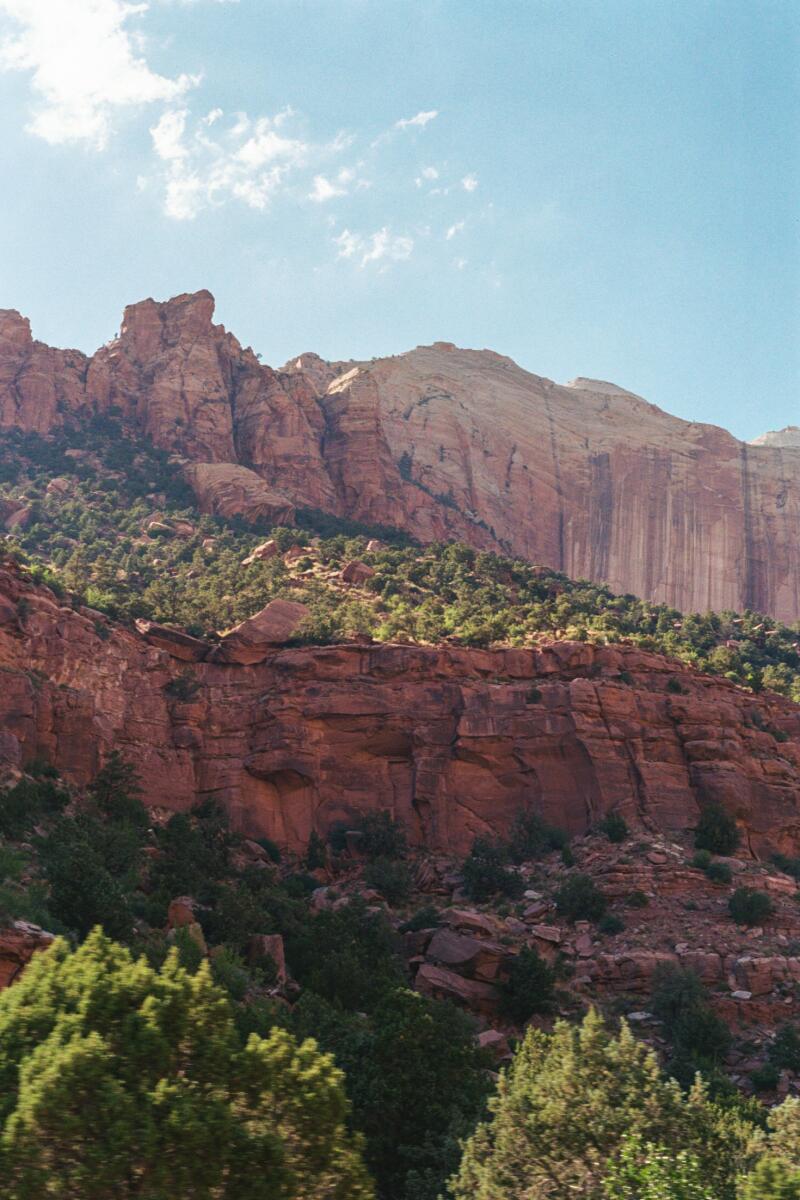
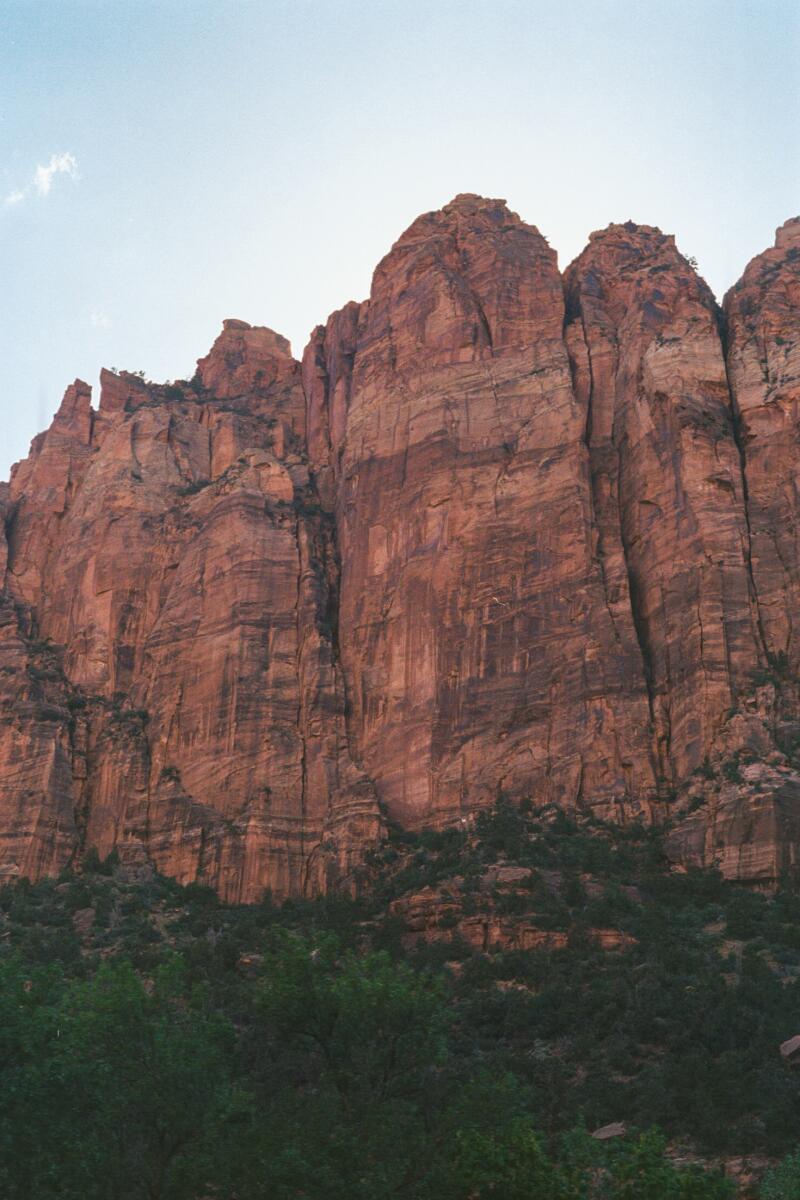
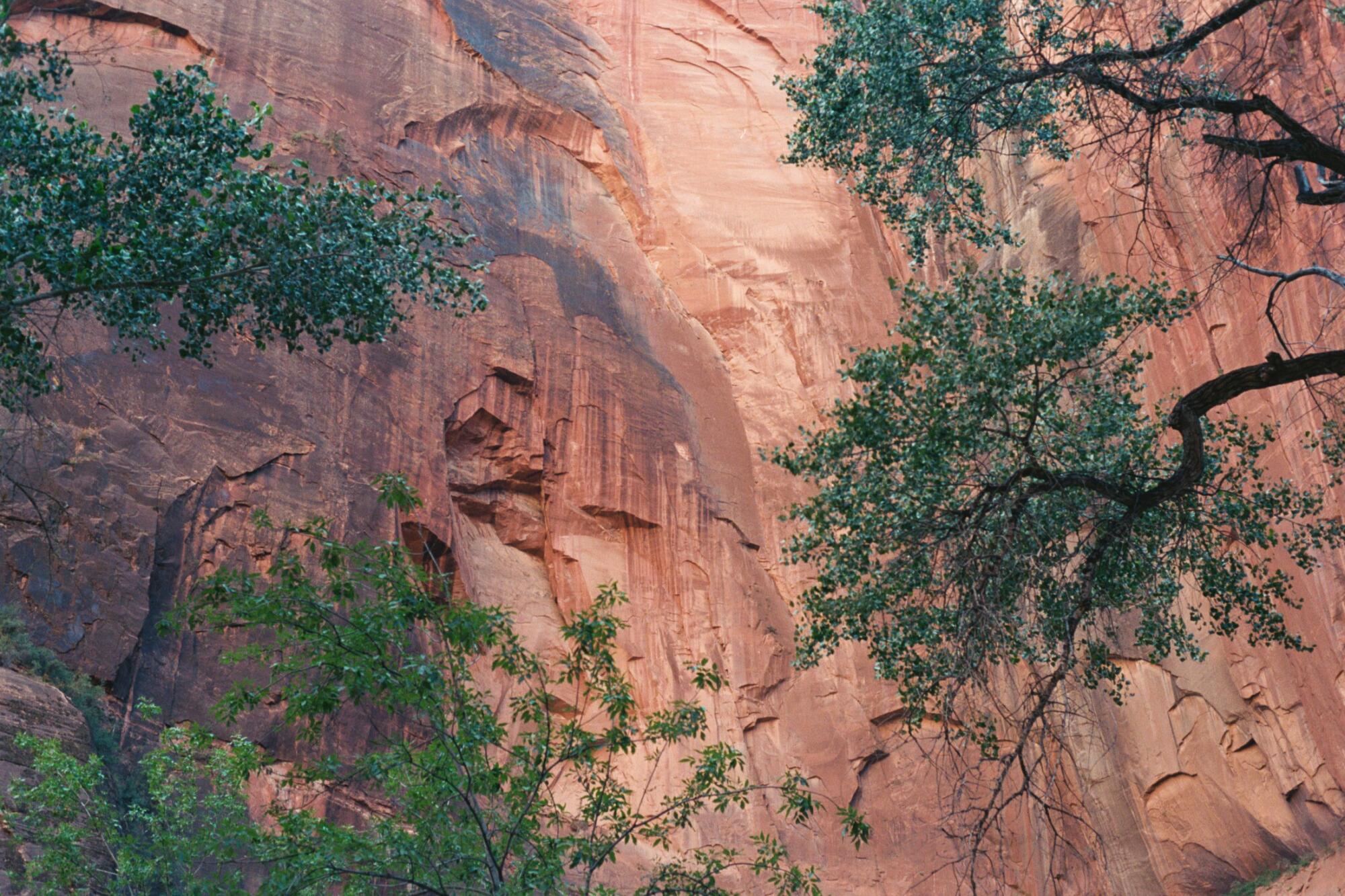
Sweeping rocky vistas towered over us at Zion National Park.
(Reanna Cruz)
ZION
Zion is one of those places that’s so mind-bogglingly vivid that just riding on the park’s shuttle can be meditative and emotional.
“This is one of the most beautiful things I’ve ever seen,” Re said as they gazed out the window. We spent the rest of the ride alternating between staring at the unfathomably large rocks and exchanging silly remarks.
“The dinosaurs saw this s— and now I’m seeing it — nuts!” Re mused.
And though there are a multitude of trails and opportunities for adventure in any national park, Reanna and I are more like lizards than mountain goats. By that, I mean we are not confident hikers, and would rather bask in a cozy place than reach new heights.
So instead of embarking on a challenging trek like Angels Landing or the Narrows, we decided to spend our day exploring the more leisurely Riverside Walk that leads to the start of the Narrows. About a two-mile round trip from the Temple of Sinawava shuttle stop, we were able to take in Zion’s bright orange rocks, admire the park’s lush greenery and take a dip in the electric blue Virgin River. (If you’re hoping to swim at Zion, I’d recommend bringing a dry change of clothes for your journey back to the park entrance, since there’s nothing worse than walking with chafing legs.)
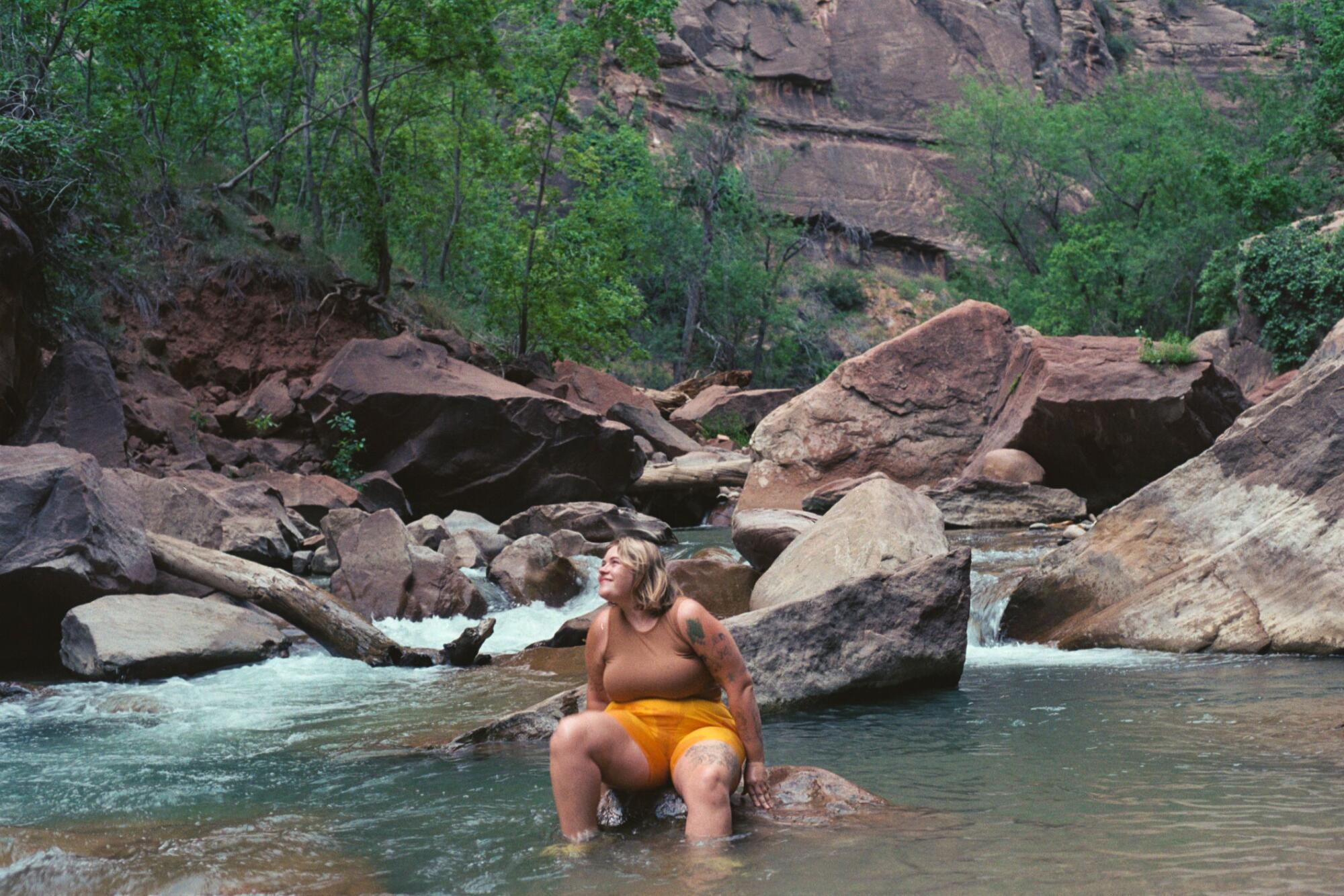
Julia swimming in the Virgin River at Zion National Park.
(Reanna Cruz)
Splashing around in such a picturesque place made me feel a deep sense of reverence, the kind of awe I only experience when I have a moment to appreciate how beautiful and vast the world can be when nature is left to its own devices.
Though we ended our long day before the last shuttle out of the park, we missed the last shuttle back into Springdale, since the two systems are, oddly, not aligned. As we walked back to the inn, we decided to get dinner at the Spotted Dog, where I devoured an ice cream-covered chocolate lava cake with such gusto that I probably scared our waiter.
At the recommendation of a reader named Kathy, who responded to my Essential California newsletter about things to do this summer, we planned our next morning around driving east on Zion’s Highway 9 to take in some of the park’s best red rock scenery. We were devastated to find that the Thunderbird Restaurant she recommended is closed on Wednesdays and Thursdays — meaning we couldn’t try any of its “ho-made” hot apple pies with buttered rum sauce — but we picked up snazzy bolo ties at the gas station across the street.
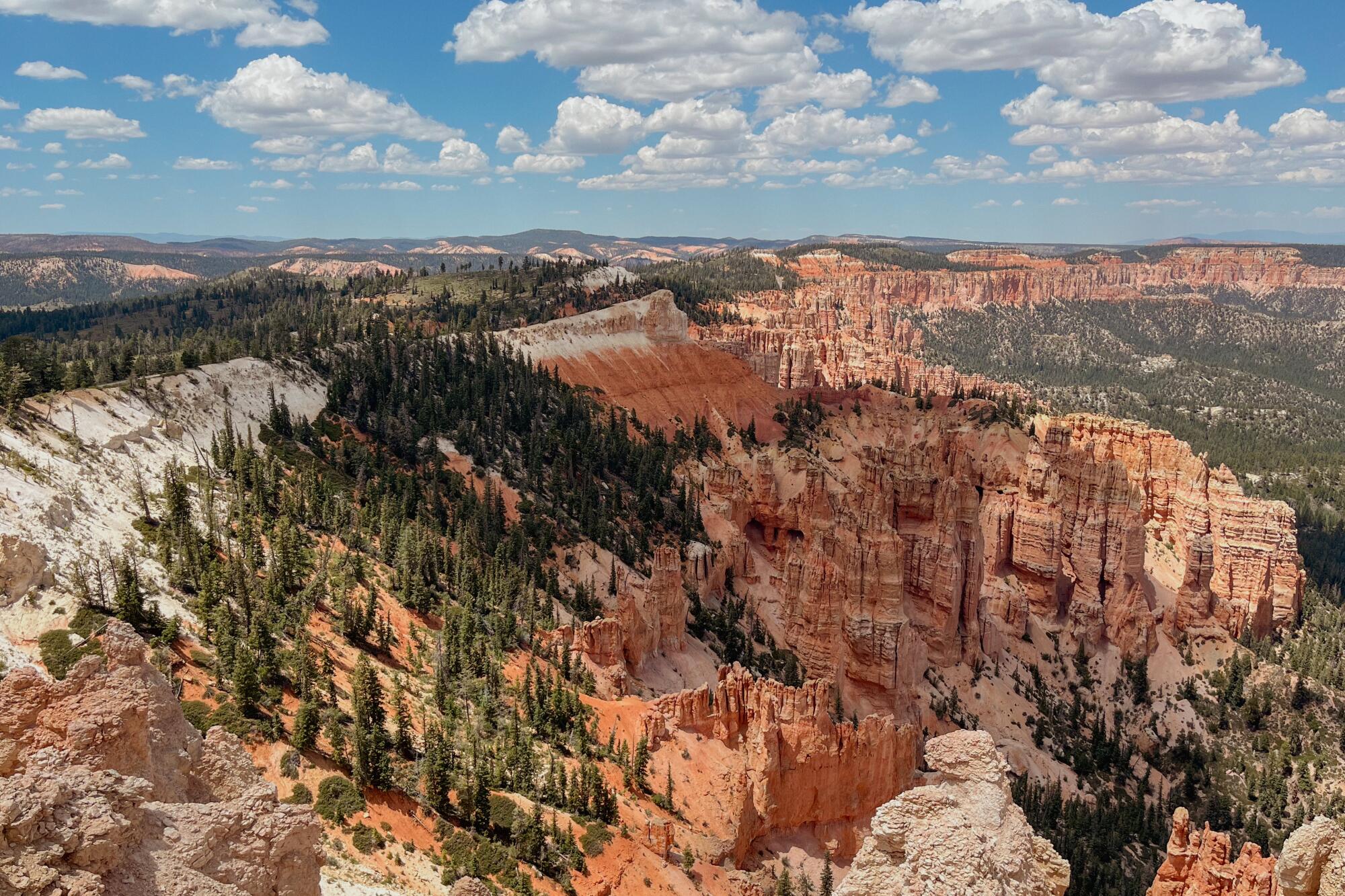
Bryce Canyon National Park from Rainbow Point.
(Julia Carmel / Los Angeles Times)
BRYCE CANYON AND CAPITOL REEF
By the time we made it to Bryce Canyon National Park, the temperatures picked up again and Reanna’s tonsils started battling an illness that we later dubbed “demon strep.” As we drove up the park’s southern scenic drive to Yovimpa and Rainbow Points to see the greatest concentration of hoodoos on Earth — tall, totem-pole-like rock pillars formed from weathering and erosion — it became increasingly clear that Re had to see a doctor. They sat in the passenger seat as we descended the scenic drive, and at each lookout point I ducked out of the car to take photos so they could see the hoodoos we were passing.
Though we hustled through the park for Re’s sake, I found the hills of spindly hoodoo spires quite hypnotizing. It’s odd to encounter terrain that’s entirely different from anything you’ve ever seen before.
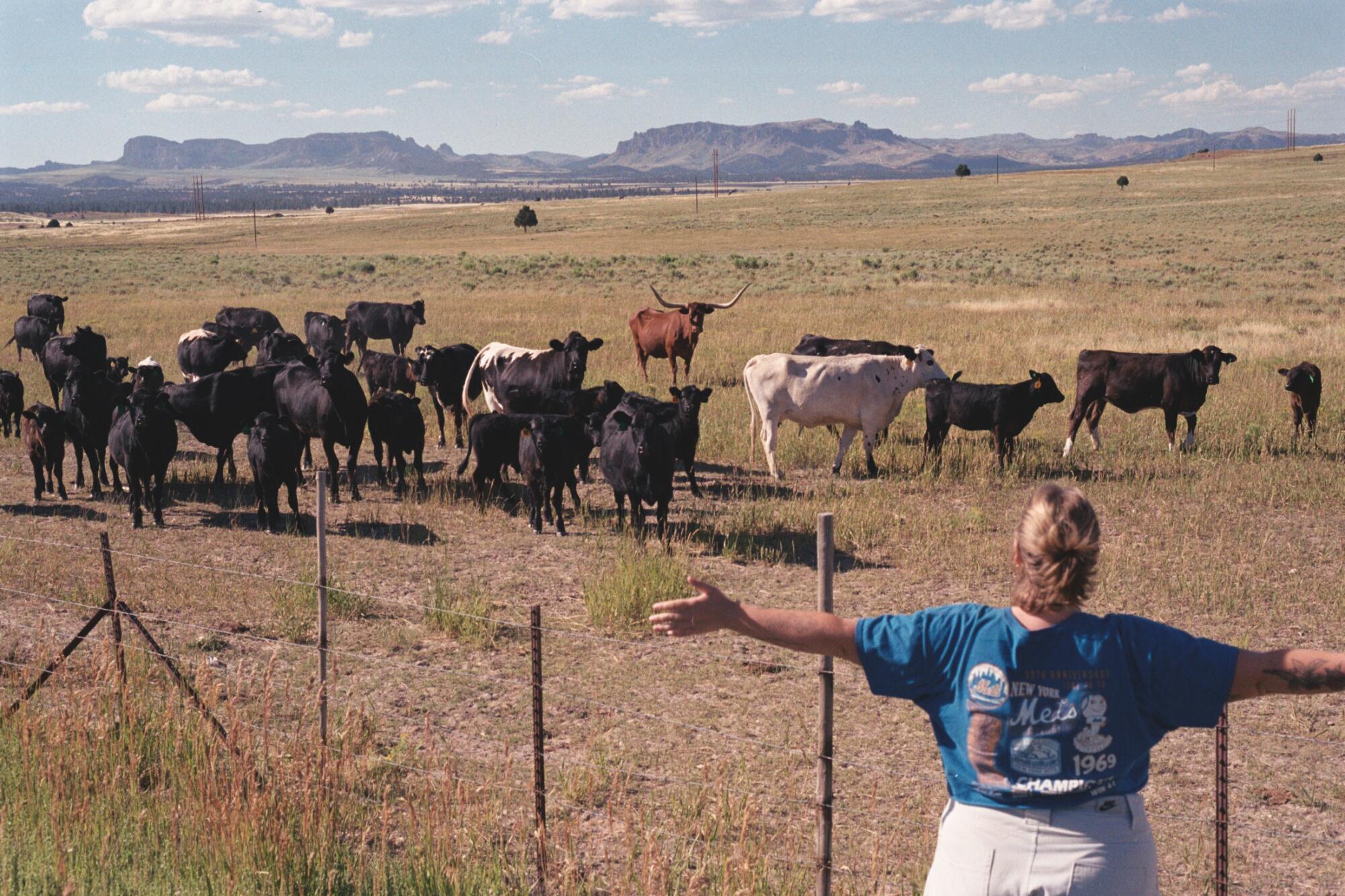
Cows along Utah’s Scenic Byway 12 between Panguitch and Tropic.
(Reanna Cruz)
After a stop at the hospital — where the doctor looked at Re’s inflamed tonsils and said, “Oh, good heavens!” — we picked up their amoxicillin at the only pharmacy in town and got back on the road to Capitol Reef. On the way to Torrey, Utah, I got a call from my mechanic, who said my car was fixed and ready to go, and found some lovely open ranges where I got to greet herds of free-roaming cows. Our luck seemed to be turning around.
But the next morning, after sleeping in one of those underwhelming clear geodesic domes that are all over Airbnb, Re somehow felt worse. After they attempted to eat breakfast (and instead had a harrowing bathroom trip), I drove us over to Capitol Reef and we continued our routine: Re sat in the passenger seat like an Oregon Trail character with dysentery; I hopped out to take photos of the cool surroundings; I showed them the photos in the car; and we dutifully carried on.
And though the rocks were stunningly red, my favorite part of Capitol Reef was stopping at the park’s Gifford House, which sells thousands of fruit pies every year between Pi Day and November. While I picked up a phenomenal strawberry-rhubarb pie and an equally delicious apple pie, Re got to hang out with a beautiful horse who lives near the park’s homestead. (Utah has a ton of roadside cows and horses, if that tickles your fancy just as much as it did ours!)
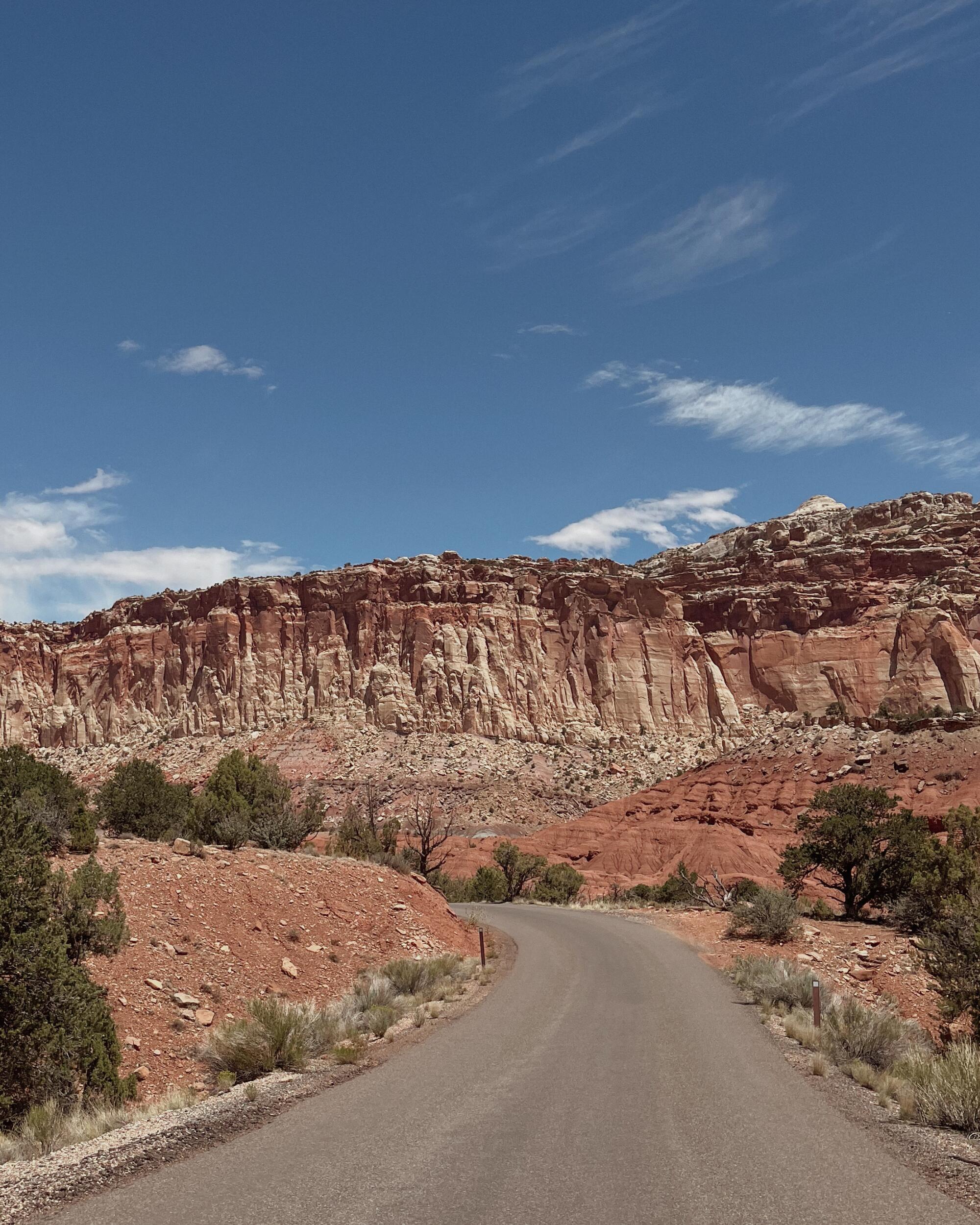
Red rocks along the scenic drive at Capitol Reef National Park.
(Julia Carmel / Los Angeles Times)
On the way farther East, I was determined to find a small market called Mesa Farm in Caineville, Utah. Though it doesn’t come up properly on digital maps, we followed the mile markers on Highway 24, counting until we hit marker 102 and saw the hand-painted Mesa Farm Market sign with rudimentary illustrations of goats.
Mesa Farm Market isn’t a restaurant — you’ll likely get a cutting board with a few knives — but the atmosphere is absolutely lovely. We got to sample an array of five goat cheeses, which were so delicious that my soft-cheese-hating partner even gave them a taste, and talked with the young farmer who’s been living there (with no running water and limited Wi-Fi) and helping the farm and market this summer.
As Re and I sat on the porch with a loaf of bread, a few cheeses, a French salami, some fresh pesto and two cups of sun tea, we talked about how nice it would be to live in a more rural area like this for a little while.
“If I ever lose my job, maybe I’ll move to a place like this,” Re said.
“We could write books and live totally off the grid,” I said as I ripped another piece of bread. “Get a few cows and never look back.”
And though we entertain that fantasy of living off the land every once in a while, I know deep down that we are both divas who need access to warm showers and movie theaters, so we bid the farm dog Zig adieu and continued on our journey.
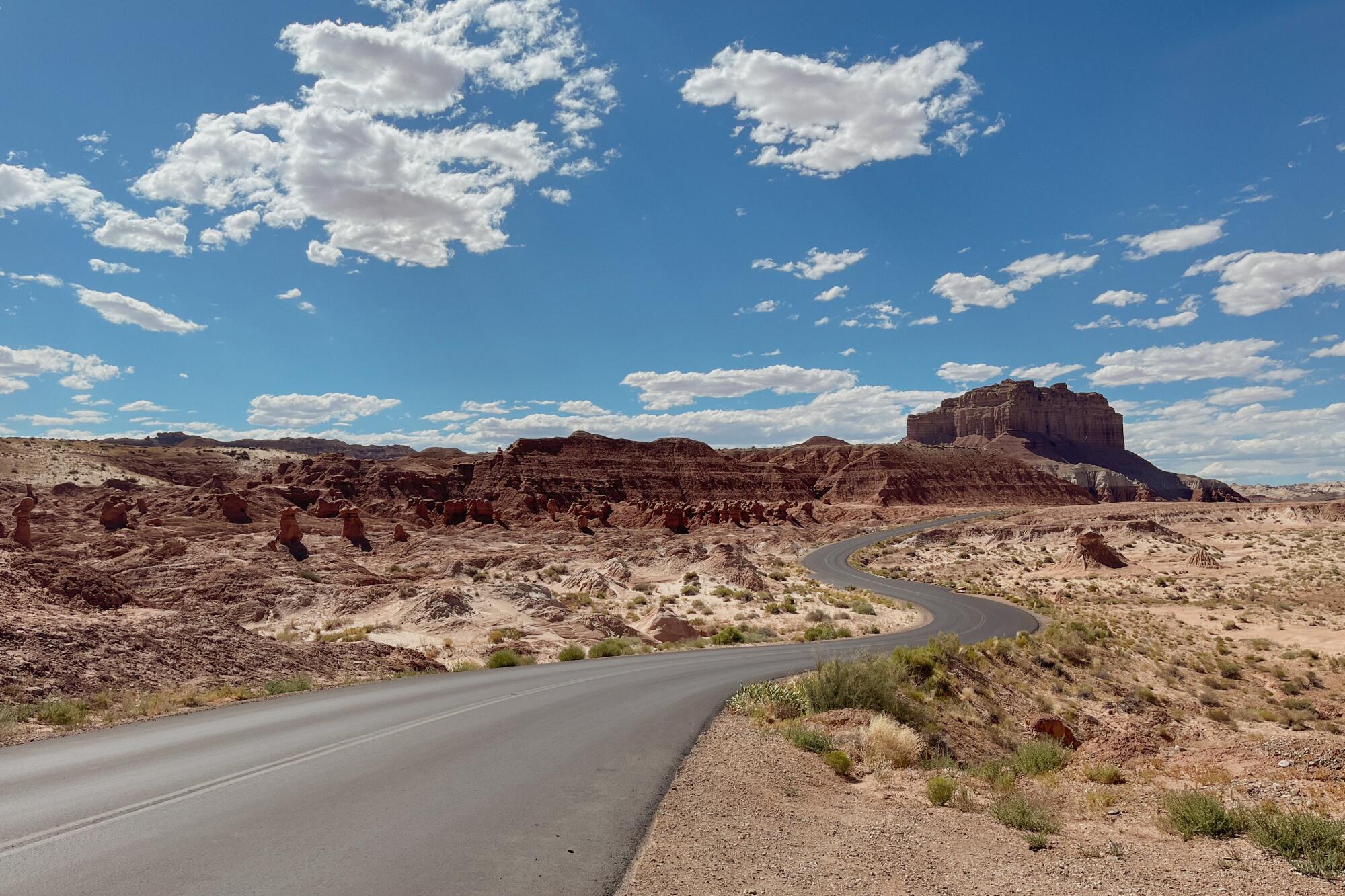
Can you spot the goblins along Goblin Valley Road in Goblin Valley State Park?
(Julia Carmel / Los Angeles Times)
GOBLIN VALLEY, CANYONLANDS AND ARCHES
Though it’s not a national park, we wanted to check out Goblin Valley State Park, which is best known as the backdrop for the movie “GalaxyQuest.” On our way there, we made two stops: The first was an art project on the side of Highway 24 called Carl’s Critter Garden, which is filled with metal dinosaurs, tiny prisms and lots of musings about a creature called “zen dog.” And after paying our respects to zen dog and his friends, we filled up our tank at Hollow Mountain — a gas station carved into a big rock.
Goblin Valley is a bit out of the way but cool nonetheless (and for those who only know “goblins” as grotesque little creatures, the word doubles as a title for the park’s unique mushroom-shaped hoodoos). There, among these bobble-headed rocks, we visited the Three Sisters and learned about the odd landscape of hard sandstone and soft siltstone that created the many goblins inside the park. And on our way out, we realized we were driving alongside a galloping pronghorn, which easily kept up with the car since these animals can run at a pace of about 60 miles per hour.
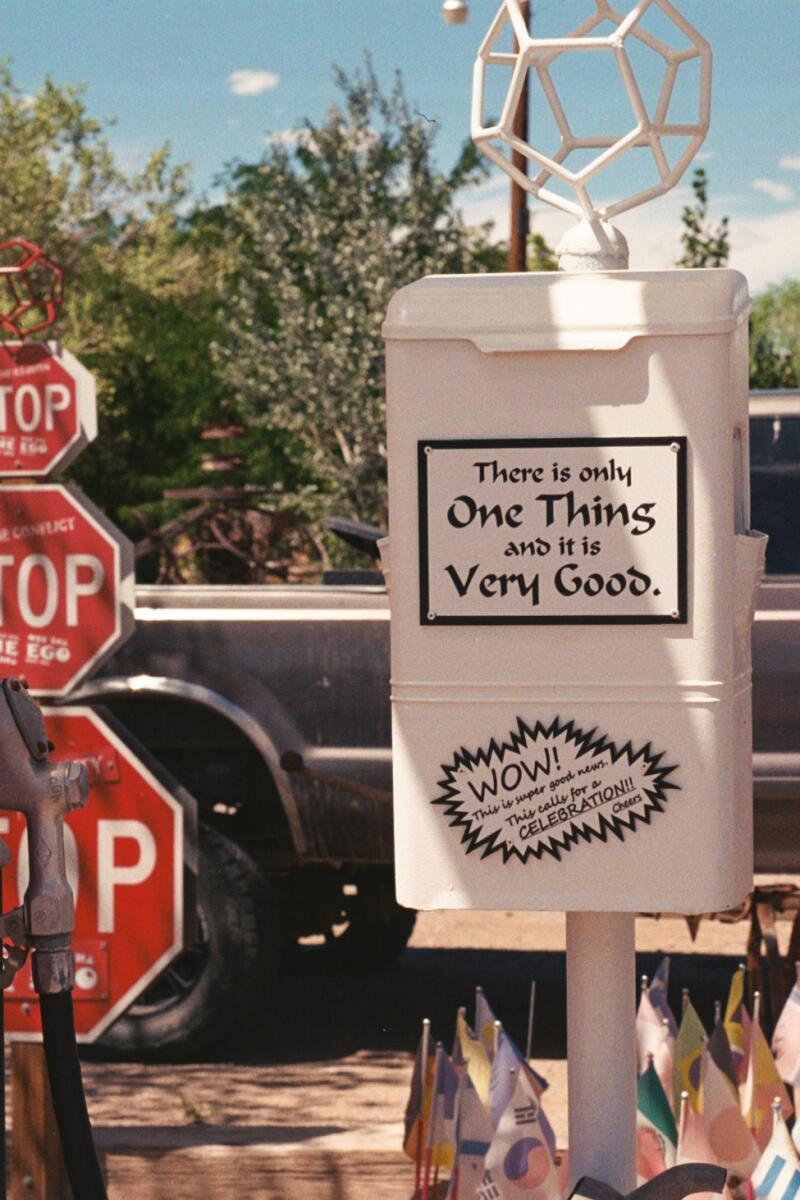
Signs at Carl’s Critter Garden in Hanksville, Utah. (Reanna Cruz)
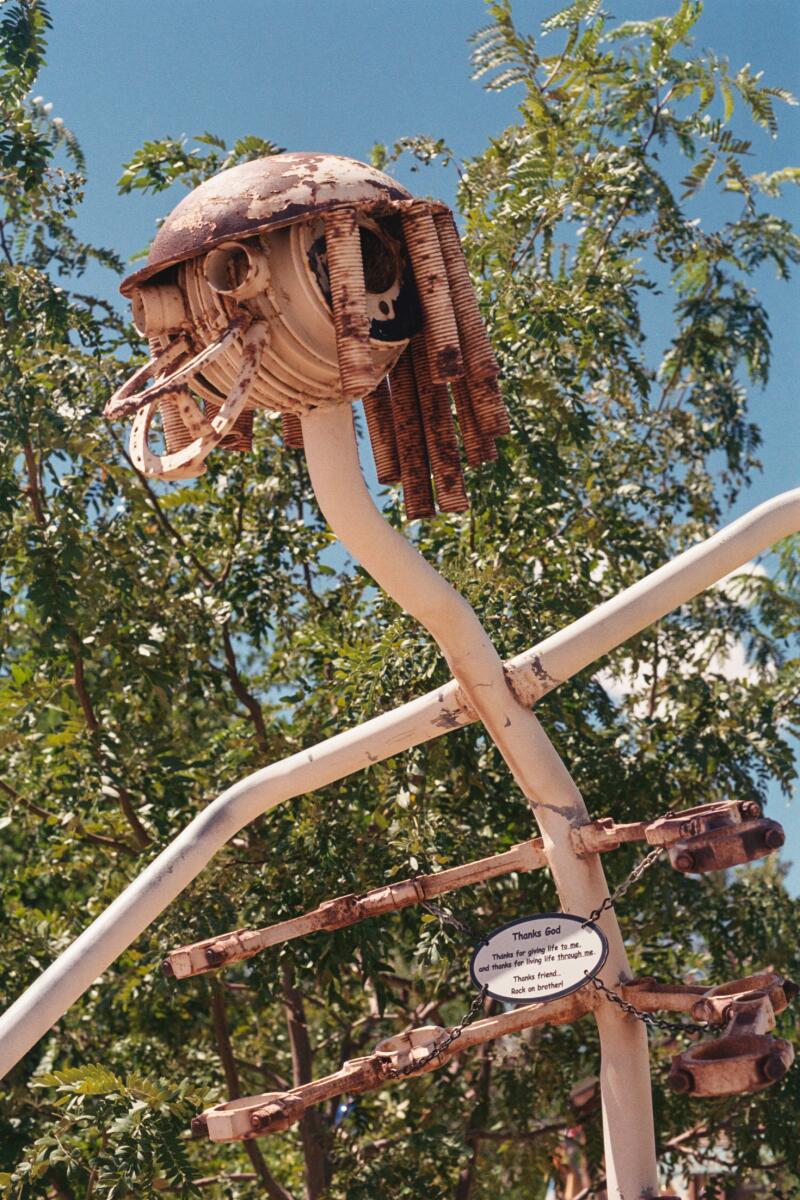
A funky guy made of recycled machinery at Carl’s Critter Garden in Hanksville, Utah. (Julia Carmel / Los Angeles Times)
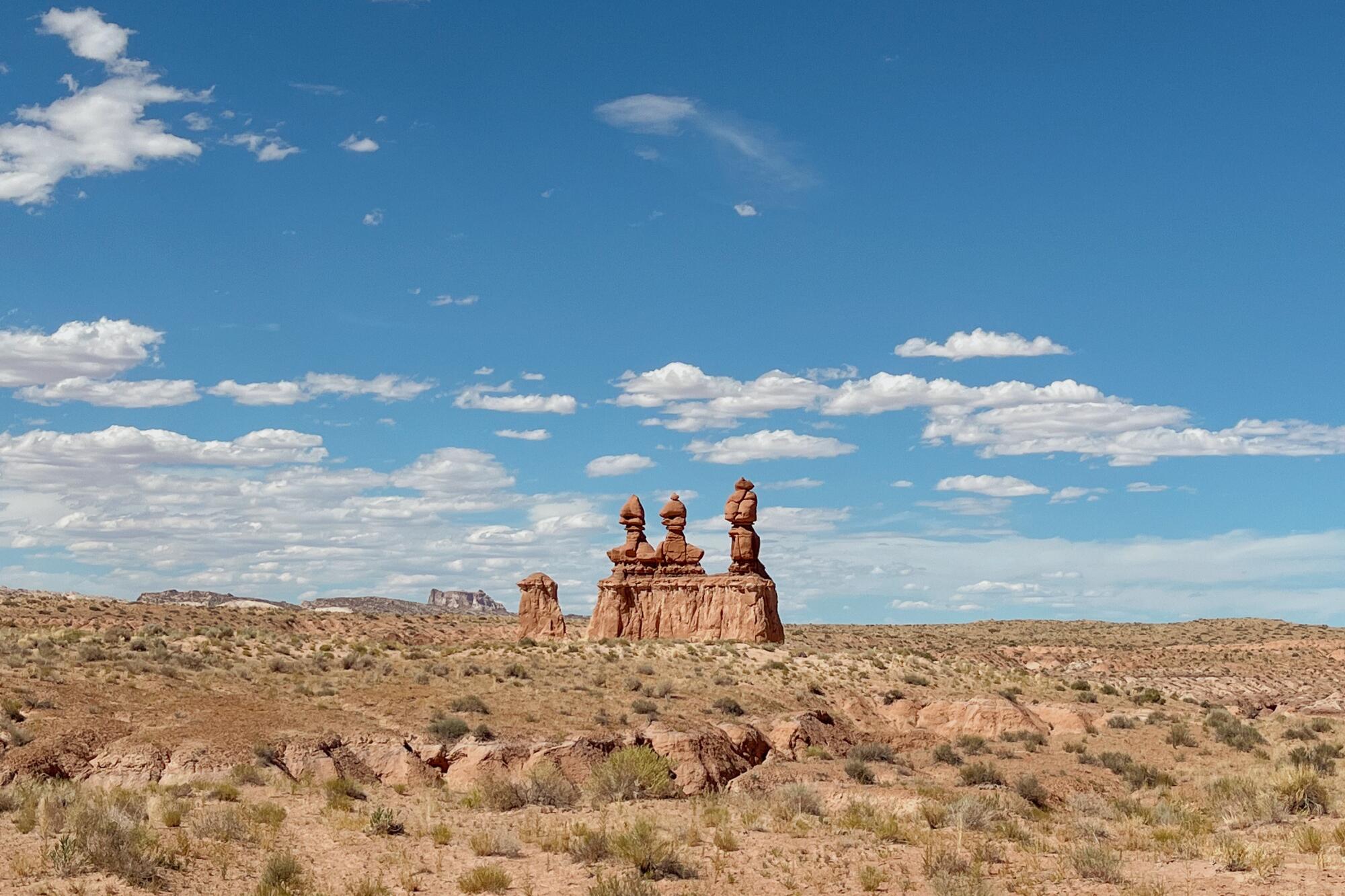
The Three Sisters at Goblin Valley State Park.
(Julia Carmel / Los Angeles Times)
By the time we made it to Monticello, Utah, Re’s throat was feeling worse, but the dysentery jokes got infinitely funnier when we checked into our Airbnb for the night: It was a covered pioneer wagon.
The next morning we rose early, since we were trying to fit two different entrances for Canyonlands and a trip to Arches into the same day. (Sometimes we must set ourselves up for failure and learn the hard way.)
As we made our way into the Needles district of Canyonlands, we realized every other car heading into this region was a Jeep with four-wheel drive. Most of the roads in that district are backcountry roads — meaning our little rental wouldn’t get us very far — but we visited Newspaper Rock, did a dutiful lap of the short scenic drive and hit the road as soon as Re thought their throat might be closing. Truly, what’s a worse place to have a medical emergency than inside a remote region of a national park?
When we finally got to an urgent care in Moab, we realized we probably wouldn’t have time to explore the park’s popular Island in the Sky district — so it goes.
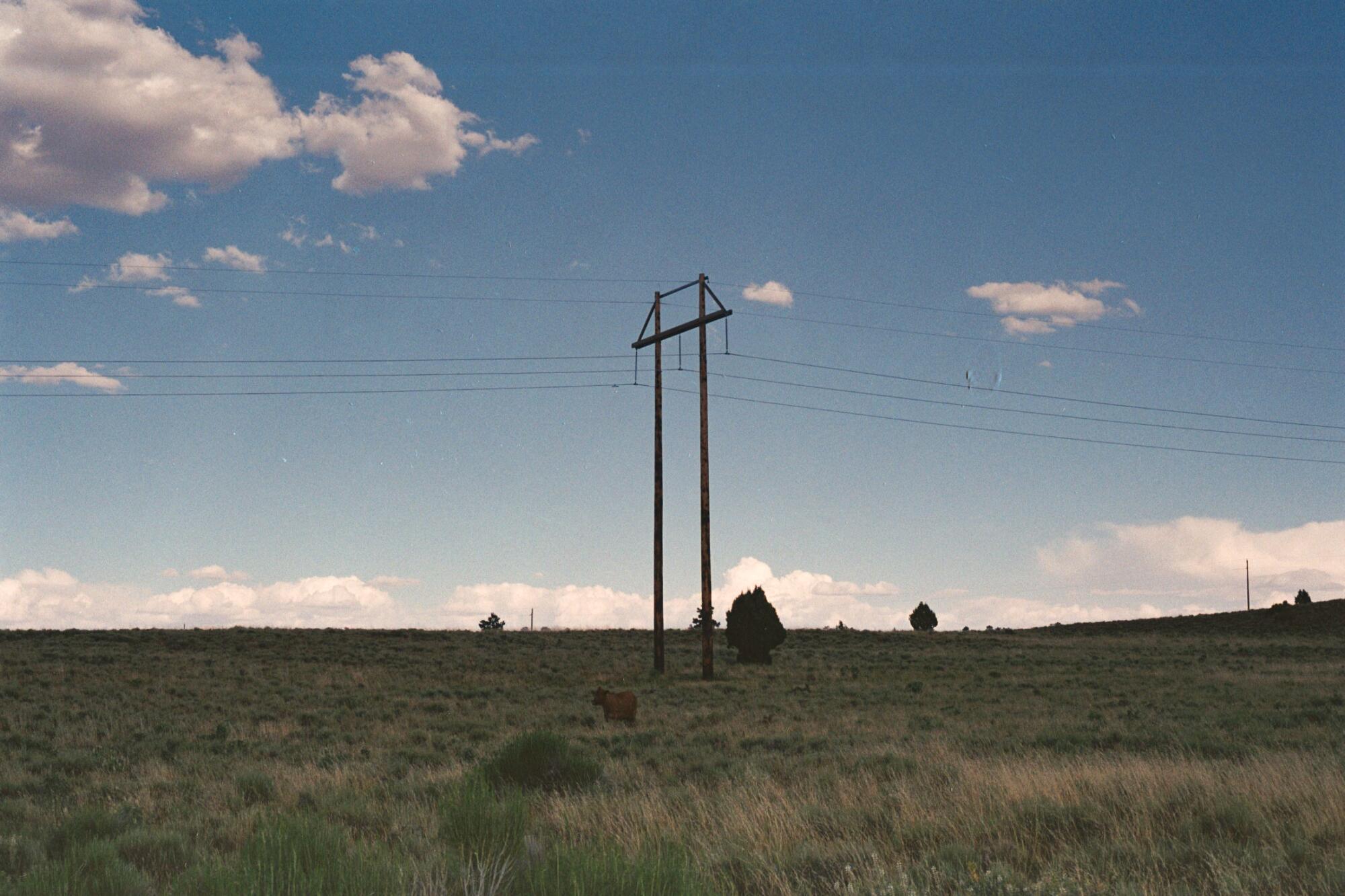
A power line on the roadside in Utah.
(Reanna Cruz)
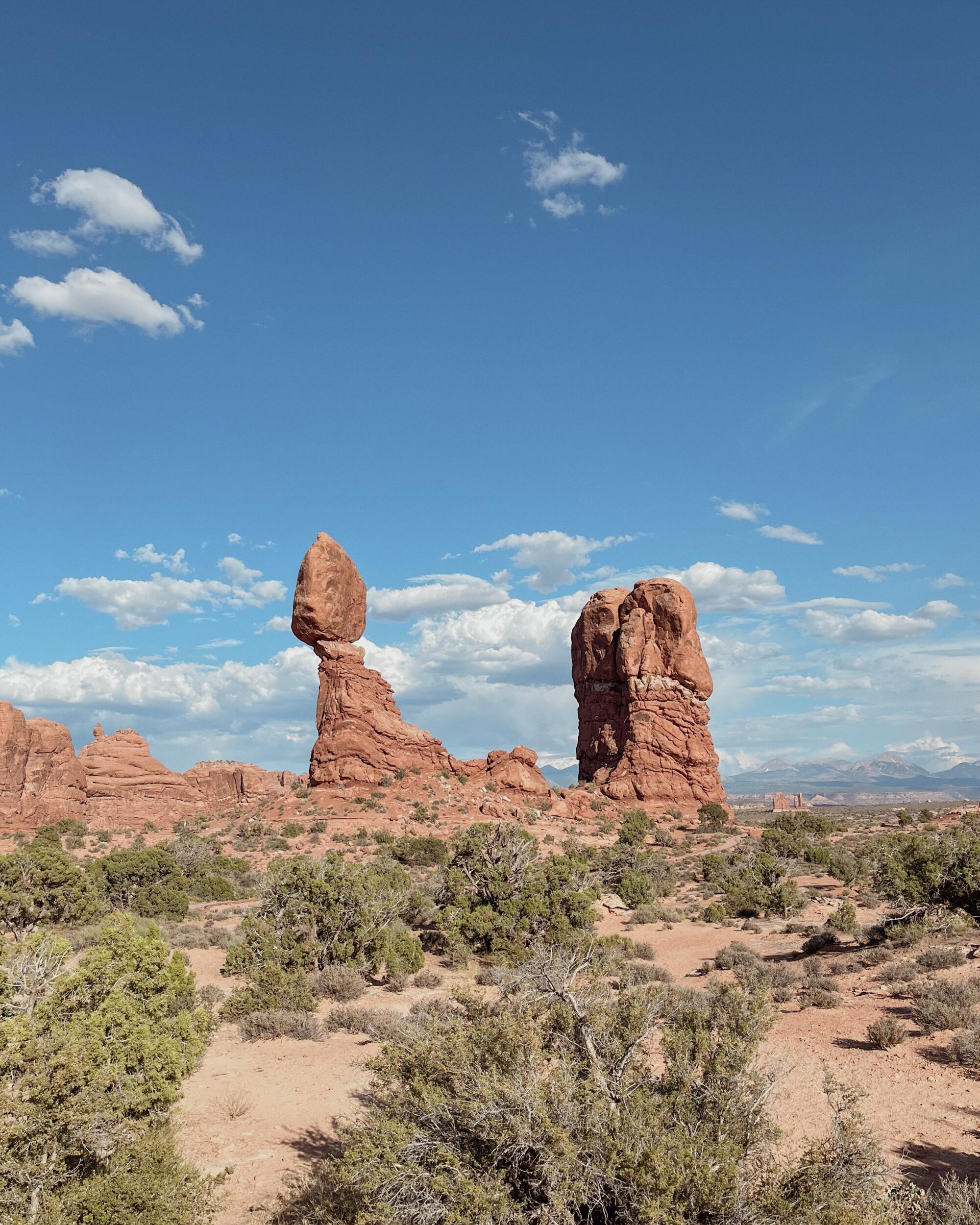
Balanced Rock, an iconic formation topped by a 3,600-ton boulder, at Arches National Park.
(Julia Carmel / Los Angeles Times)
At our second urgent care, Re got an unpleasant penicillin shot that’s often referred to as “the peanut butter shot” because the medication is so thick. But after spending several hours there, we decided to stop at Moab’s Thai Bella for a much-needed bowl of tom kah soup and a phenomenal sous vide duck. Finally, we bravely continued to our last Utah national park.
Arches National Park is a bit too small for the number of visitors it attracts, but that’s why they now use timed entry reservations. We decided to go after 4 p.m., since that’s late enough to forgo a reservation and miss the peak temperatures of the day, which meant the roads were fairly empty.
After seeing the rest of Utah’s parks, Arches’ popularity can be a bit mystifying. “Why is Delicate Arch the most famous?” I heard one child ask a park ranger, referring to the iconic structure that graces Utah’s license plates.
Perhaps it was just the end of a very long day, but we both felt like we had seen enough once we checked out the various roadside overlooks and visited one particularly gross bathroom. (I was admittedly warned that the park is a bit of a tourist trap, but I’m one of those stubborn people who likes to determine things firsthand.) The drive from Arches to our next abode in Fruita, Colo., passed a lot of towns with no gas, restaurants or bathrooms, so I’d recommend getting your business in order before leaving Moab.

A truck outside of Dinosaur Journey Museum in Fruita, Colo.
(Reanna Cruz)
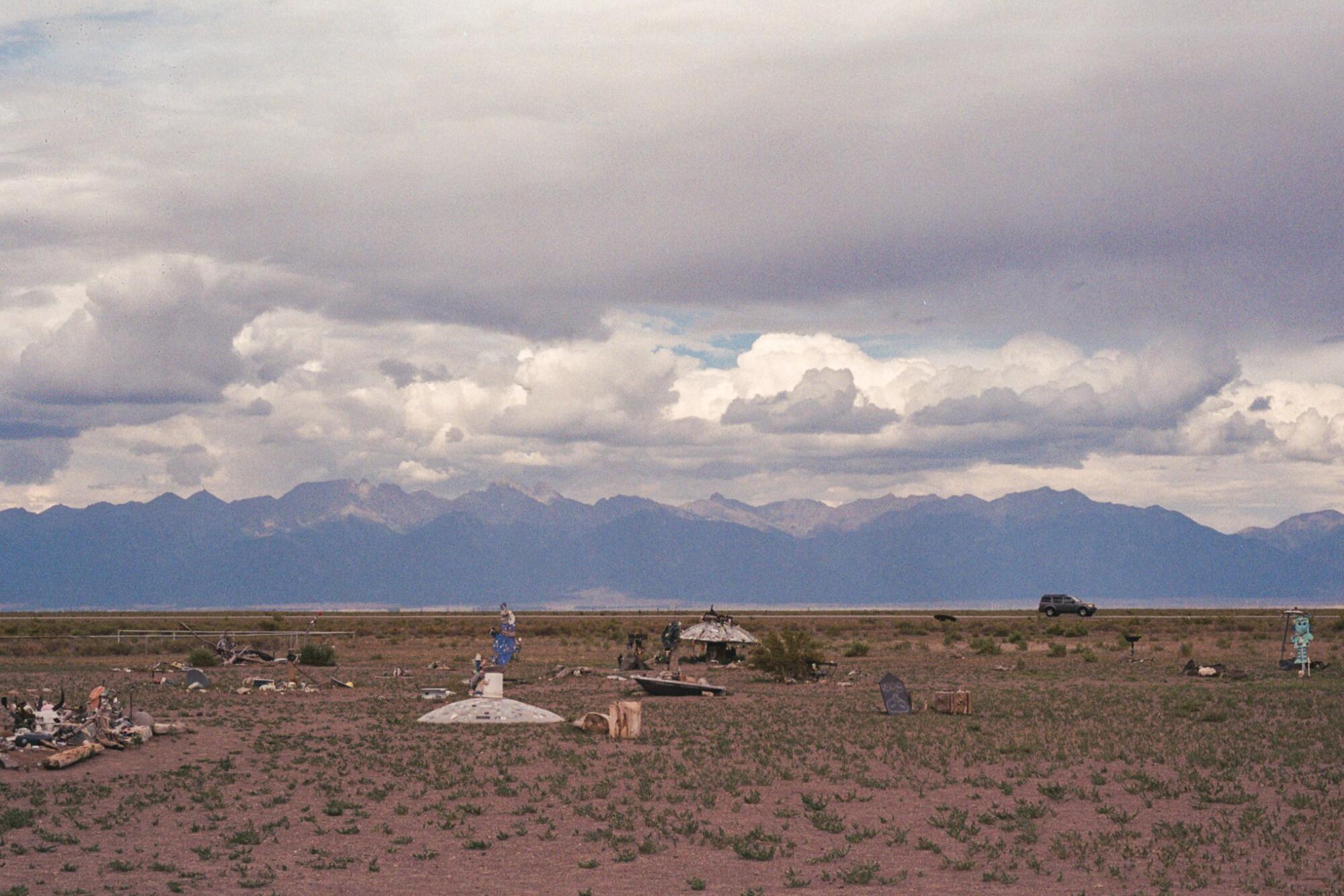
Clouds above the UFO Watchtower in Colorado.
(Reanna Cruz)
Cooling off with Colorado’s canyons, sand dunes and UFOs
Fruita is a small town about halfway between Moab and Black Canyon of the Gunnison National Park that’s best known as home to Mike, a local chicken that was able to survive without a head for 18 months in the 1940s. After a night of blissfully cool and quiet sleep there, we made a pit stop at Dinosaur Journey, where Re cried because they were so excited to see all the local fossils, and I bought a glow-in-the-dark T-rex shirt that was definitely meant for a child.
BLACK CANYON OF THE GUNNISON
By the time we made it to Black Canyon of the Gunnison, we were pretty excited to see something other than the hoodoos and arches that we were starting to take for granted. This park was like a full reset: The temperature dropped, the crowds thinned out and the rocks looked like nothing we had ever seen.
Though some people will understandably rank parks based on how challenging or expansive they are, I’d rather remember the way I felt when I visited. So, if you’ll humor me and indulge in that mindset, I can safely say Black Canyon of the Gunnison was one of my favorite parks on this trip, with soaring drop-offs and magnificent metamorphic rocks that made us feel tiny and inconsequential in the best possible way.
As we stood at the edge of the painted wall overlook, Reanna raised their arms to catch the wind as it moved through the canyon. We stayed there for at least half an hour, taking photos for strangers and returning to the edge several times to catch the air under our arms and inhale the crisp breeze.
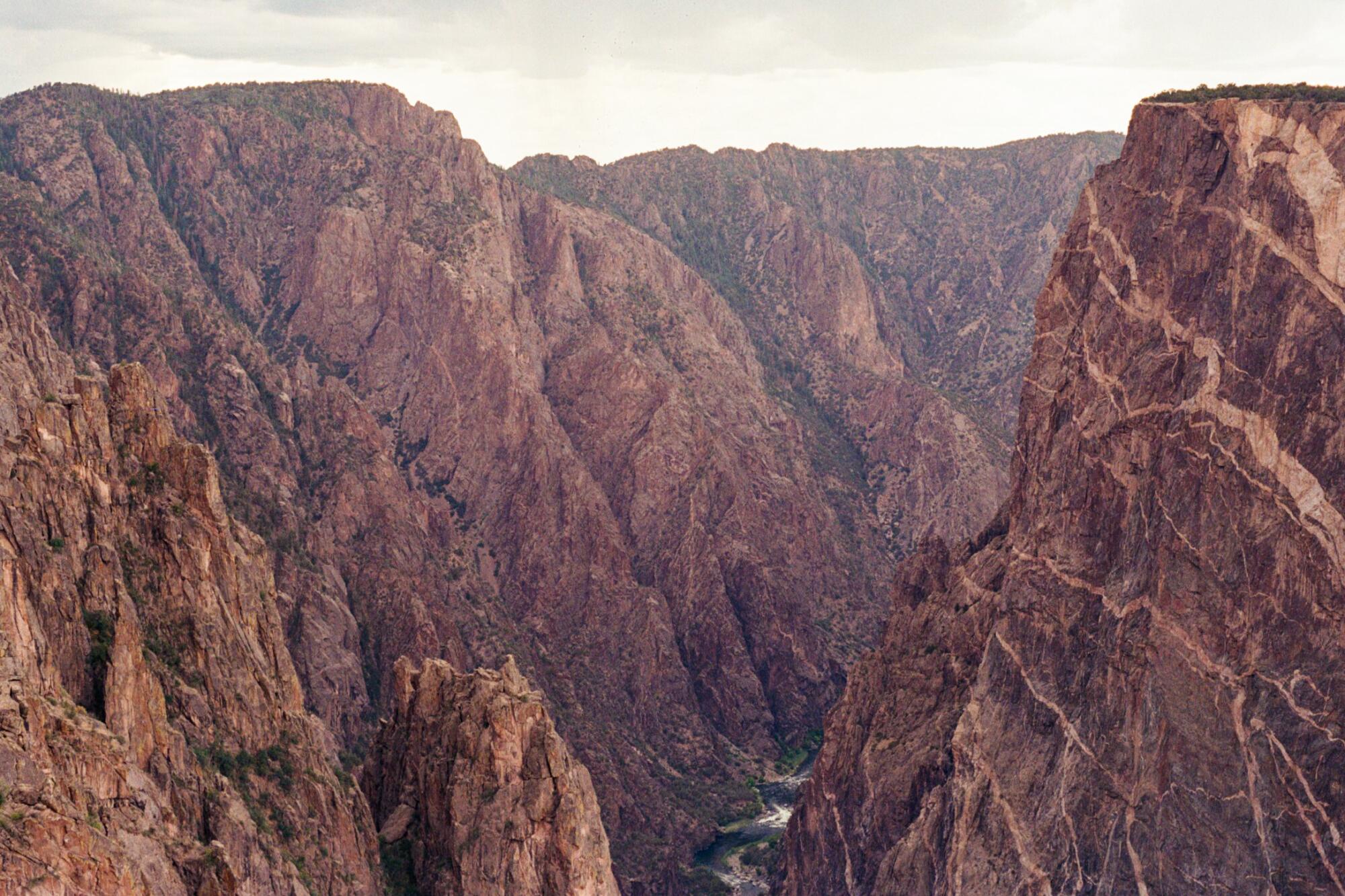
Colorado’s Black Canyon, which has some of the world’s oldest exposed rocks.
(Julia Carmel / Los Angeles Times)
We decided to grab dinner in the town of Gunnison at High Alpine Brewing Company, which made a great day even better. By the time we hit the road an hour later, I was happily stuffed with a beet and goat cheese salad, half a High Alpine pizza (with lemon-basil ricotta, veggies and garlic oil), and a smoked cherry old-fashioned that was presented in a dramatic glass cloche.
From there we were about two hours from Leadville, which claims the title of “highest incorporated city in North America” at 10,152 feet above sea level. After driving past lakes and through national forests, we made it to the Colorado Trail House, where we were able to snack on a few Twinkies, do a much-needed load of laundry and take a glorious bath in our room’s bright purple tub.
The next morning, after we stopped for breakfast at my aunt and uncle’s house on our way to Denver, Reanna spotted a sign for Rocky Mountain National Park and asked the toughest question of the trip: “Why aren’t we stopping at that park?”
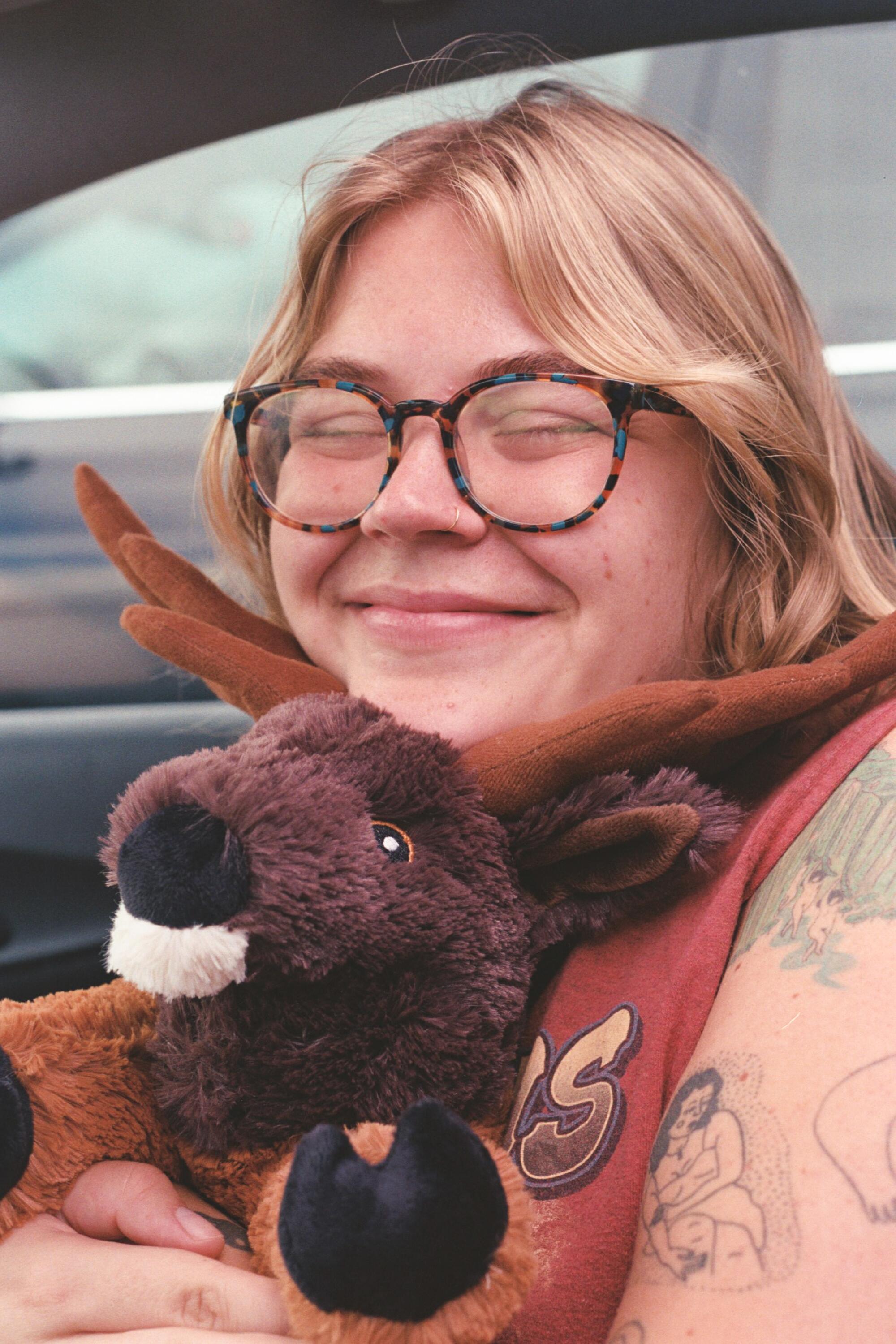
Julia and a new Elk stuffed animal named Peanut from the gift shop at Black Canyon of the Gunnison.
(Reanna Cruz)
And though I wish I had a better answer, the truth is that I was too distracted planning our visit to the nearby Red Rocks Park and Amphitheater. (And though I neglected the most popular park in Colorado, my colleague Chris was able to write a few of his best tips on our road trip map.)
We had just arrived in Denver before we had to drop our bags at the Queen Anne Bed & Breakfast and head to Red Rocks to claim a seat for the Big Thief and Lucinda Williams concert. And though a nasty thunderstorm nearby didn’t seem to be working in our favor, we endured a rainy two-hour wait for the venue’s doors to open.
The whole process felt a bit like a pilgrimage — driving over 1,000 miles to face thick sheets of rain and waves of thunder — but eventually the venue gave the OK to move inside. We bought some dry shirts and ponchos and settled on an open bench. As everyone watched the show, lightning bolts seemed to come down when the music would swell to a climax, underscoring Adrienne Lenker’s impassioned wails and giving the whole night a mystical feeling. After experiencing Red Rocks’ phenomenal acoustics, national park-worthy red sandstone rocks and an otherworldly performance, our elaborate journey to Colorado and back felt completely vindicated.
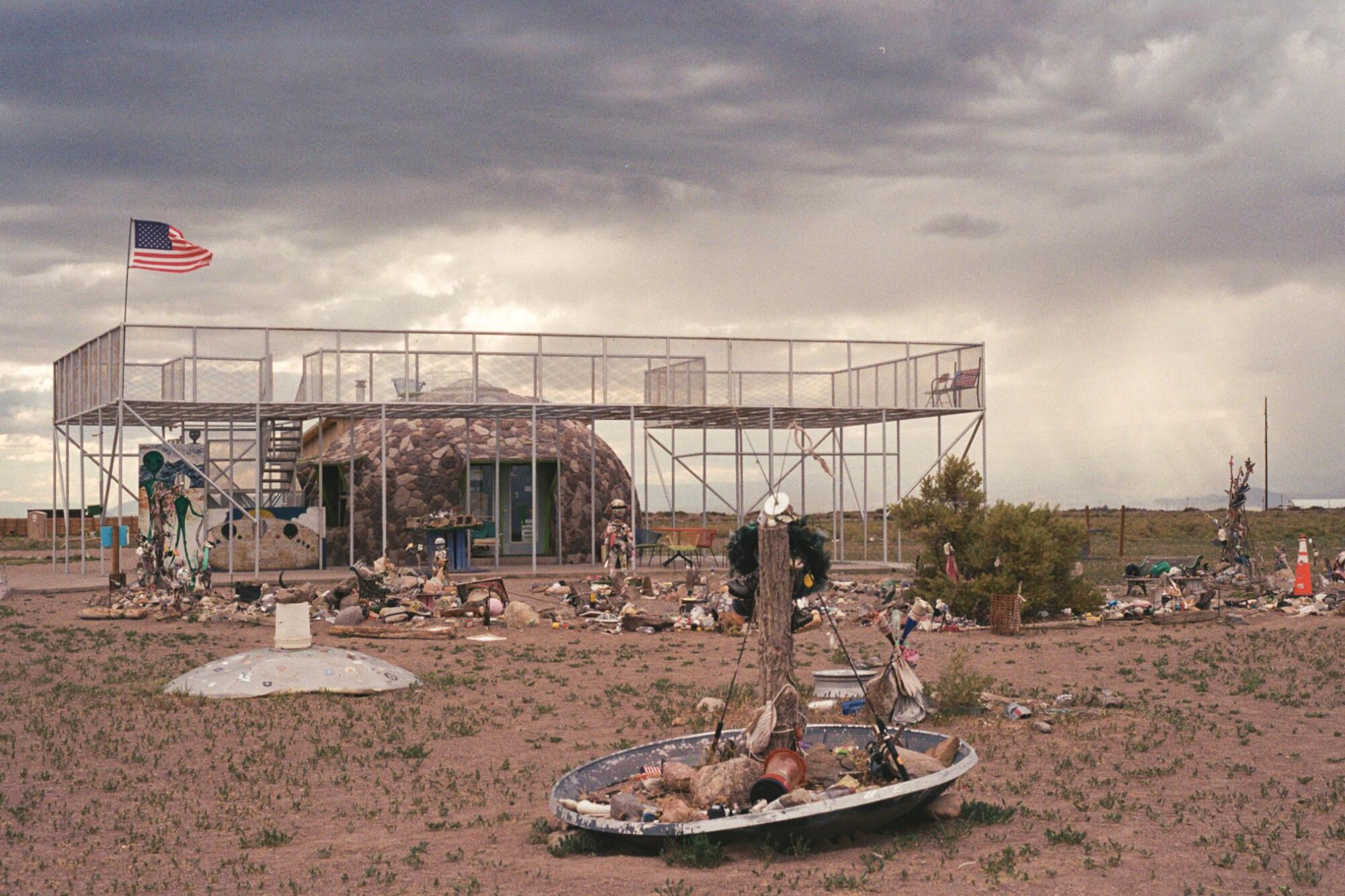
The observation deck at Colorado’s UFO Watchtower.
(Reanna Cruz)
GREAT SAND DUNES AND MESA VERDE
In the morning we were back on the road, heading to the largest sand dunes in North America. This was an especially fruitful route for roadside attractions, so we stopped at the Sasquatch Outpost in Bailey and later the UFO Watchtower in Hooper. (If you couldn’t already tell, we are fascinated with otherworldly creatures.)
After leaving some snacks, pens and several hot sauce packets from my car at the UFO Watchtower garden (which is thought to overlap with two large vortexes of energy), we picked up sand sled rentals and hit the slopes.
As we approached the sand dunes it felt quite bizarre, like someone hastily dropped a randomly generated feature on Earth without wondering whether it actually belongs there. With another storm rolling in, we didn’t get to ascend any of the park’s tall peaks, but we had enough fun wandering around the lower planes of the Great Sand Dunes National Park & Preserve. This area is an exercise in admiring the unusual, offering the chance to marvel at a landscape that’s equally simple (it’s basically a huge sandbox) and perplexing (scientists still don’t know how old these massive dunes are). On our way out, there was even a double rainbow, which only added to the enchanting and strange vibe of the surrounding San Luis Valley.
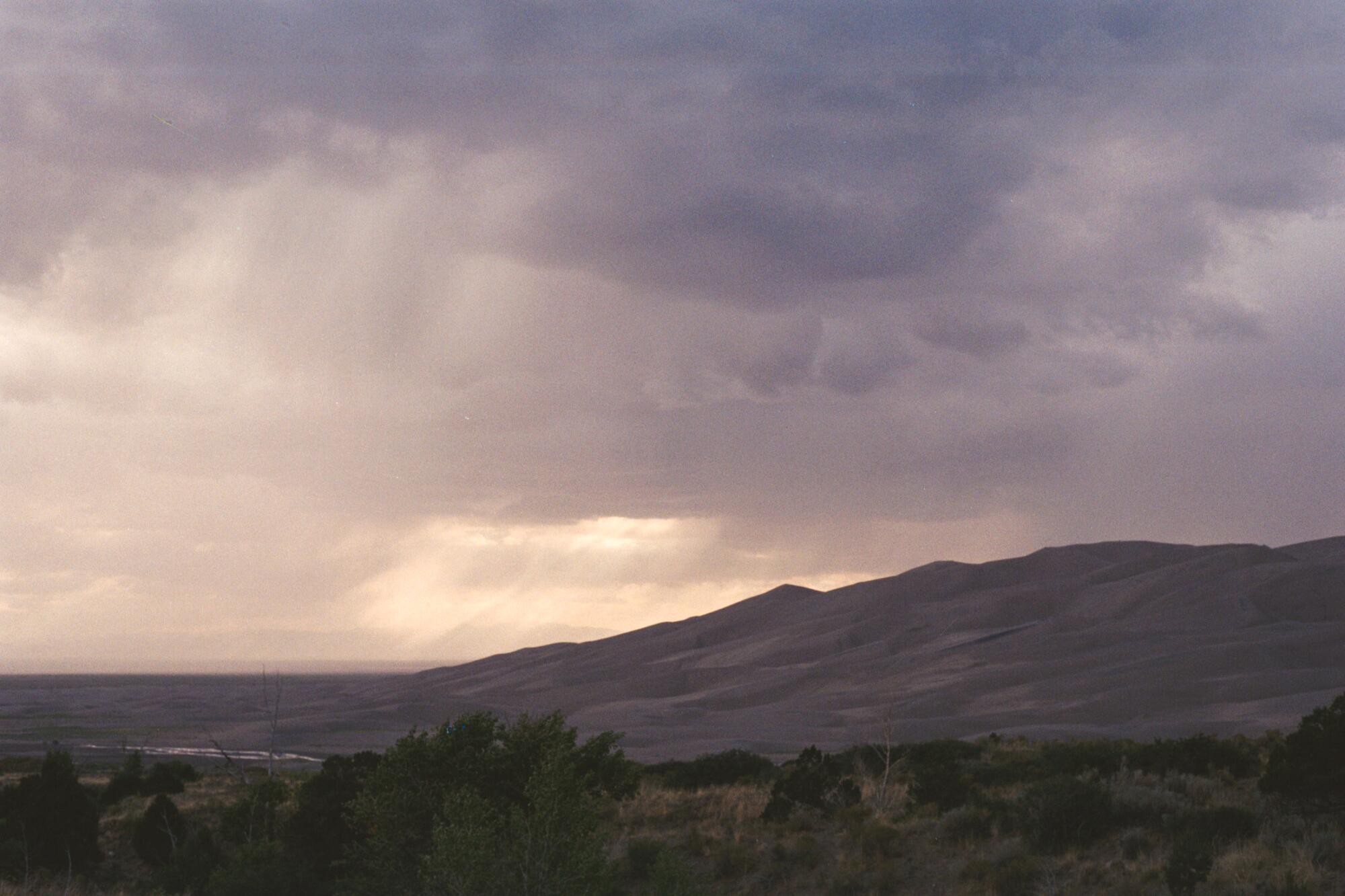
Rain over Great Sand Dunes National Park and Preserve.
(Reanna Cruz)
Once we realized our Airbnb was in a fairly remote town with few restaurants, we decided to head in the opposite direction for dinner at the Rubi Slipper, where we ordered two of the most satisfying diner hamburgers on our burger-heavy trip and Re contemplated trying Rocky Mountain oysters (though they chickened out).
As we drove back toward the park to drop our sand sleds and head to Crestone — which is one of the major spiritual centers of America — Re began feeling disconcerted by how dark and empty the surrounding area looks at night. Like being outside on a cruise ship in the middle of the ocean, there was virtually nothing around us but pitch-black roads, which are understandably freaky if you think about them for too long. If you’re afraid of wide open spaces, perhaps rural livin’ is not for you.
But after a night of sleep in our Crestone dome, we woke up to the quaint and strange little town, where the majority of residents were wearing mala beads and natural deodorant. As we left one of the few local coffee shops, we overheard people chatting about the full moon and passed a lone shirtless man strumming his guitar from the back of his parked pickup truck.
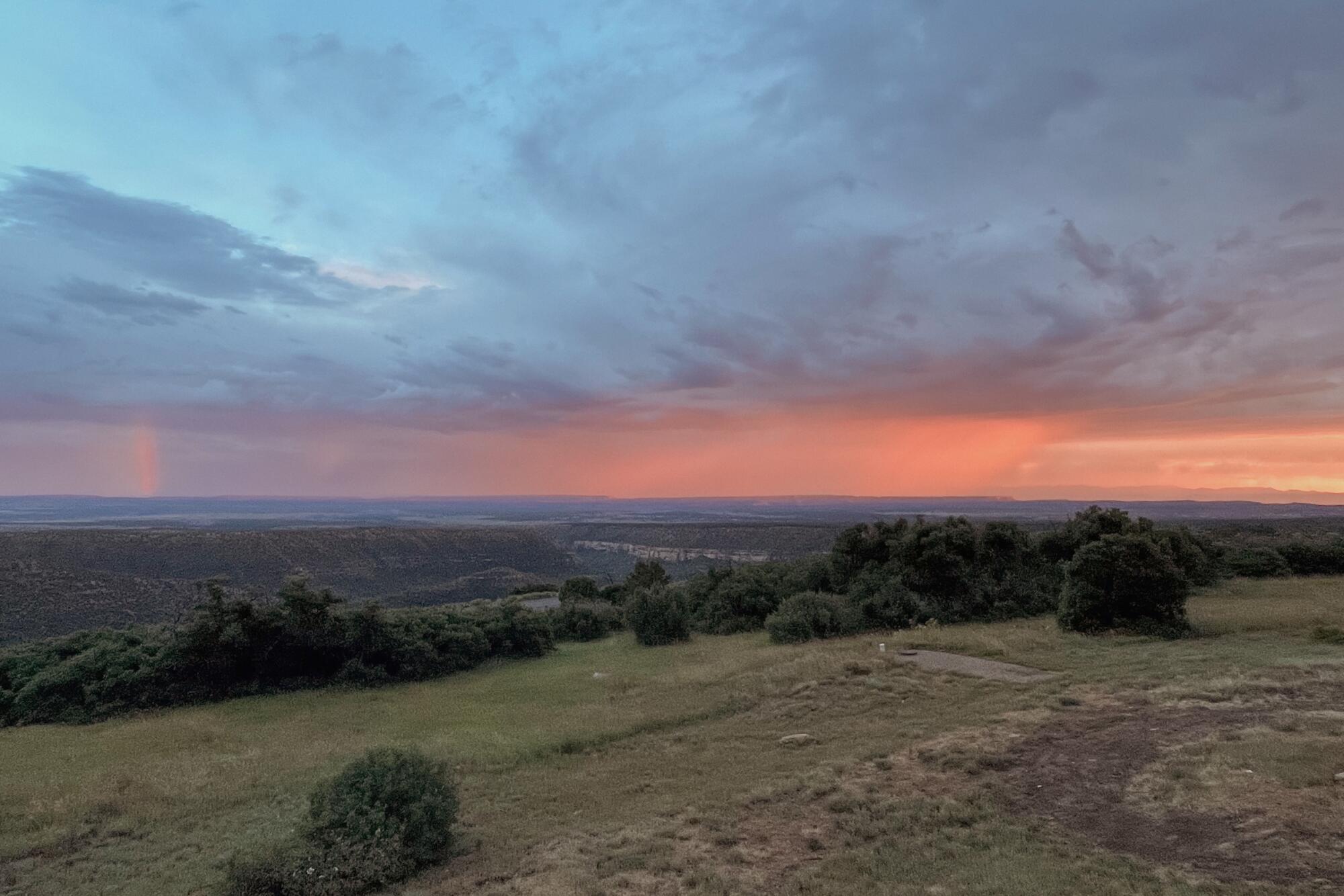
Sunset and a rainbow outside of the Metate Room Restaurant at Mesa Verde National Park.
(Julia Carmel / Los Angeles Times)
Colorado had already yielded a wonderful array of natural wonders, but our final stop in the state was Mesa Verde National Park, the nation’s largest archaeological preserve. The hottest commodities in the park are the ranger-led cliff dwelling tours, which include visits to balcony house and cliff palace, but we felt fine seeing cliff palace from the adjacent overlook. Though the dwellings are incredible, we spent the most time hanging out at the highest lookout in Mesa Verde: Park Point. Because most of the foot traffic is around the cliffs, we had the 8,572-foot-high area all to ourselves, so we stopped to feel the breeze, marvel at butterflies and admire the checkerboard of different greens that covers the surrounding area.
At this point you might be wondering: Can glamorous travelers like us sleep inside national parks without camping? The answer is a definite yes: Many of the national parks have rustic hotels and lodges within them, so we spent the night at Mesa Verde’s Far View Lodge, which had absolutely no cell service. Though it was too rainy to join the park’s nightly stargazing program, we decided to grab dinner and a few drinks at the Metate Room. The food was nothing to write home about, but our mediocre meal was supplemented by respectable cocktails and an even better view of the sunset.
The next morning we woke up to wild horses walking by our balcony. We did one last lap around the cliff dwelling lookout points before embarking on one of our longest driving days and heading toward Arizona.
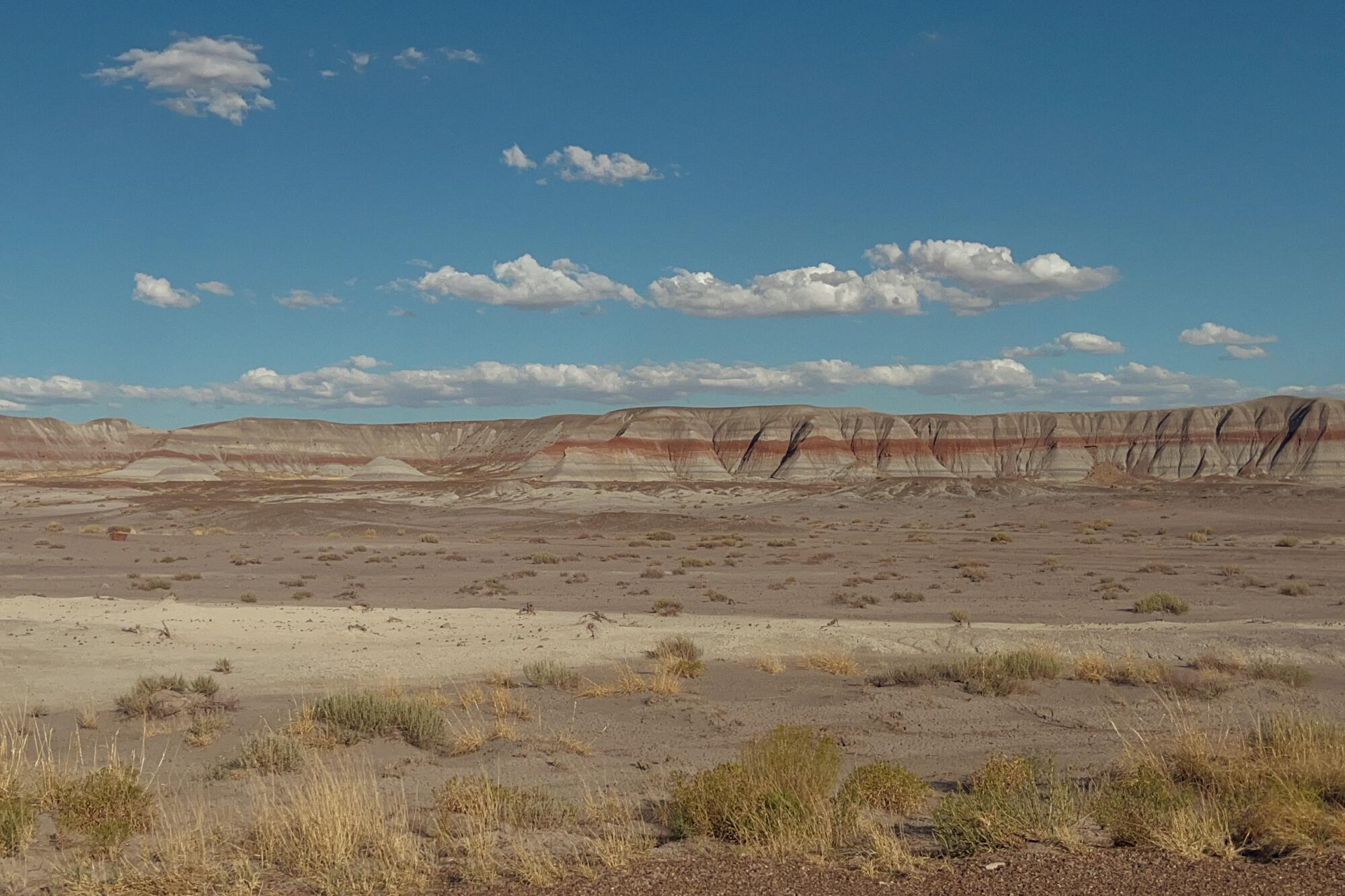
Landscapes near the Tepees South Pullout at Petrified Forest National Park.
(Julia Carmel / Los Angeles Times)
Gazing at petrified wood, the Milky Way and the grandest canyon in Arizona
The No. 1 tourist trap in the world is apparently the Four Corners Monument, but that didn’t stop us from paying $8 apiece to see where four states converge (and if you plan on going, bring cash since there’s a high likelihood that the card reader won’t work). Inside, we got some delicious Navajo frybread and took some silly photos at the point where Colorado, New Mexico, Arizona and Utah come together.
PETRIFIED FOREST AND FLAGSTAFF
Our three-hour drive through New Mexico was simultaneously brief and exhausting, so by the time we got to Petrified Forest National Park we were feeling a bit restless.
But the best way to get through the Petrified Forest is in a vehicle, since the park spans 28 miles, and it made the most sense for us to enter one side and exit the other. So we relished every lookout point, wandered the Crystal Forest — which had some of the park’s most impressive fossilized wood — and then begrudgingly continued on our journey to Little America Hotel in Flagstaff.
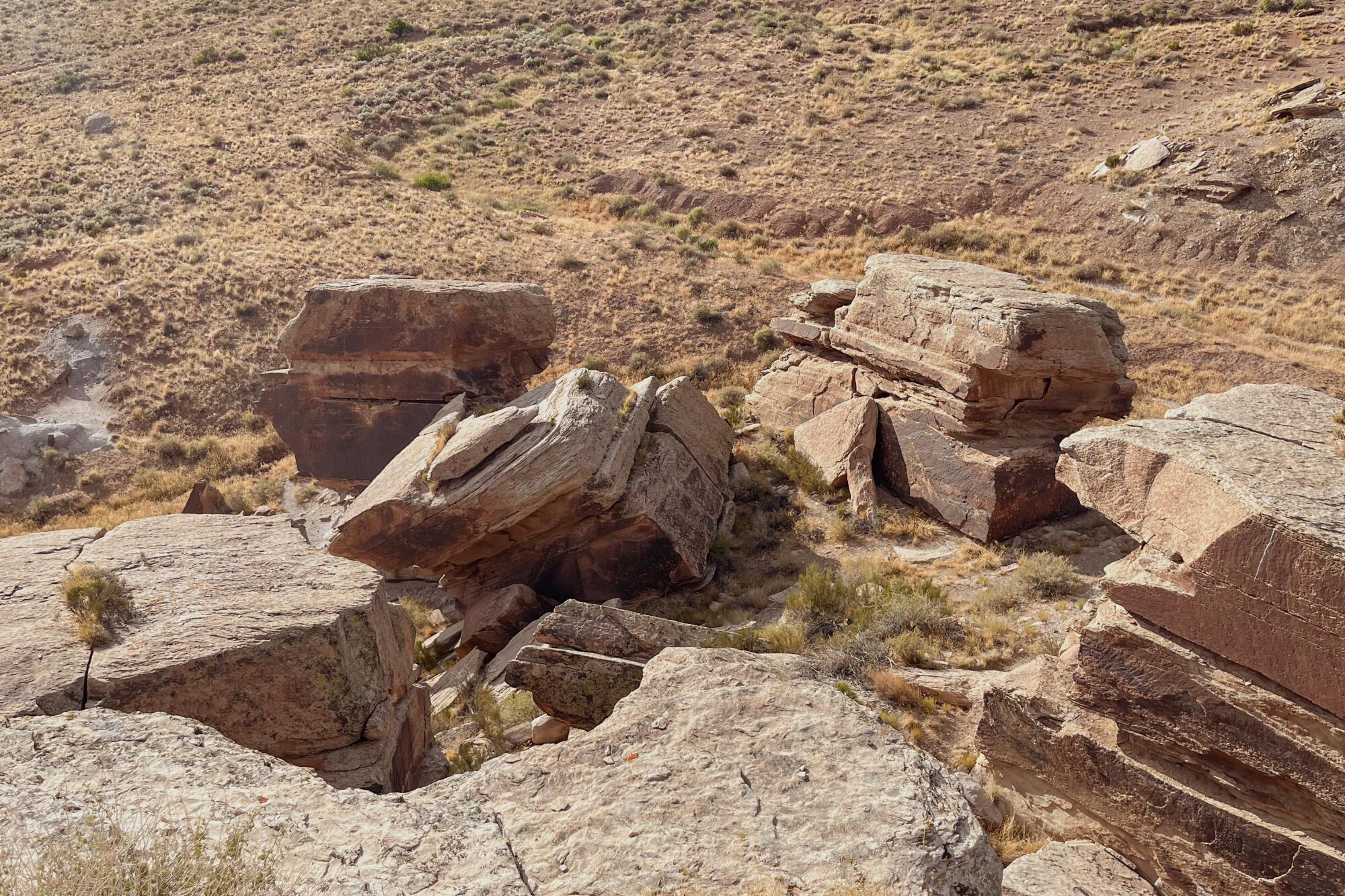
Rocks with petroglyphs on them at Newspaper Rock inside of Petrified Forest National Park.
(Julia Carmel / Los Angeles Times)
By the time we reached Flagstaff, we had spent at least 10 hours in the car, which made our brains and bodies feel like absolute mush. After a week of eating burgers and various forms of gas station starch, we were also craving some kind of fresh, veggie-forward meal. This led us to Tinderbox Kitchen, where we had what was undoubtedly the best meal of our whole road trip. After downing a spring salad, a ponzu-brined chicken over miso potato puree, and a divine duck with Brussels sprouts, we rolled our way back to our room to watch a years-old ESPN mullet championship on cable TV and fall asleep.
After thousands of miles on the road, waking up just an hour and a half from the Grand Canyon felt like racing toward a finish line (even if we still had eight hours of driving and another national park to go). Once we picked up sandwiches at Proper Meats + Provisions we were back on the road, pumped to spend the whole day at one of the most spectacular places in the world.
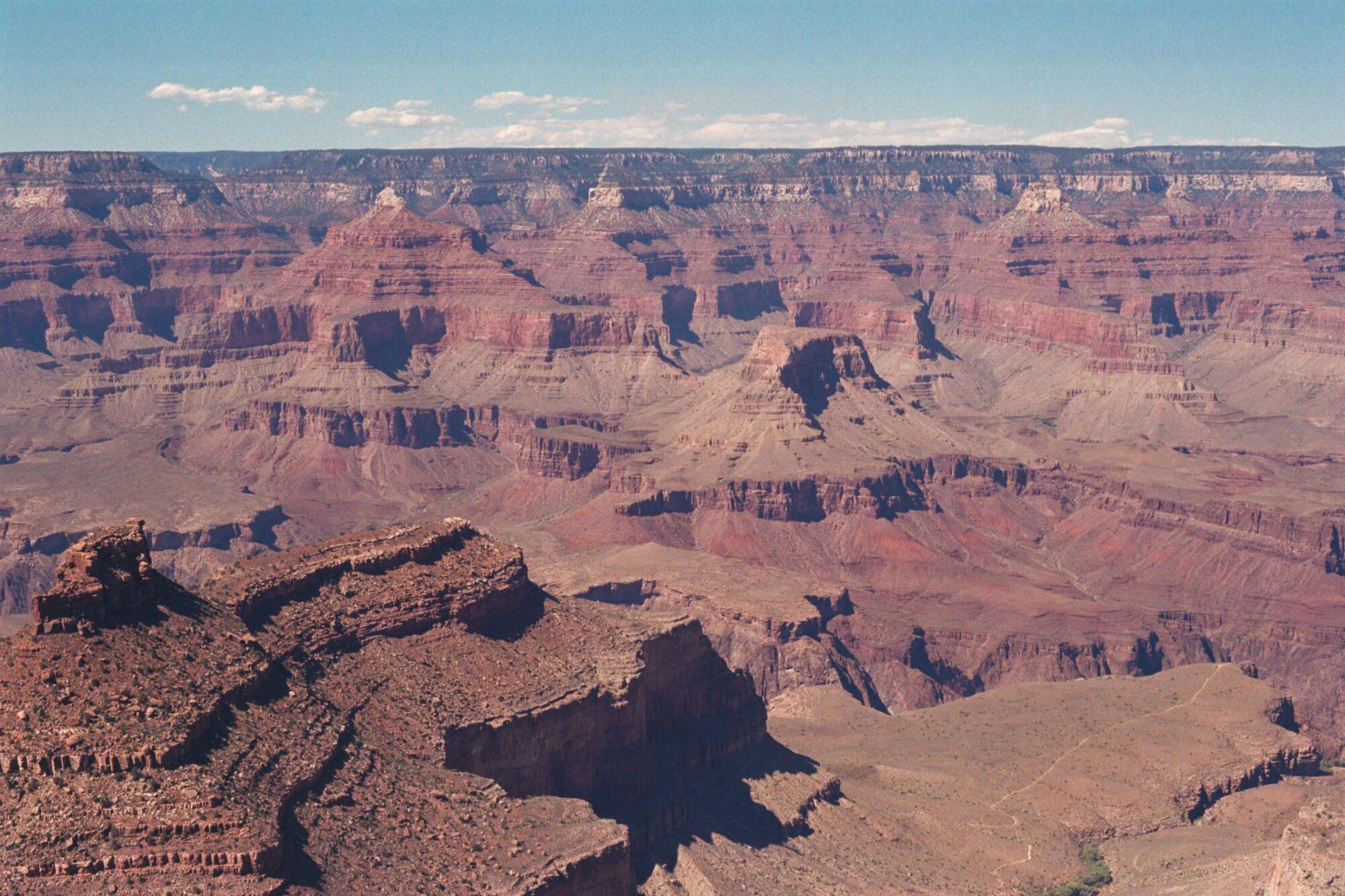
The South Rim of the Grand Canyon.
(Reanna Cruz)
GRAND CANYON
The Grand Canyon is overwhelming, with nearly 600 miles of paved and unpaved trails that get millions of visitors each year. So we started with something basic: following the Trail of Time along the South Rim to learn a bit about the canyon’s geologic timeline. Once that was completed, we were able to hop on a shuttle to explore a few different viewpoints in the park before returning to the El Tovar Hotel, where we were spending the night.
If there’s any time to splurge on a nice hotel, it’s when the hotel has been built right on the South Rim of the Grand Canyon. Even the second most visited national park empties out significantly by sunset, which meant we were able to sit by the rim and watch as the sky painted new hues on the canyon.
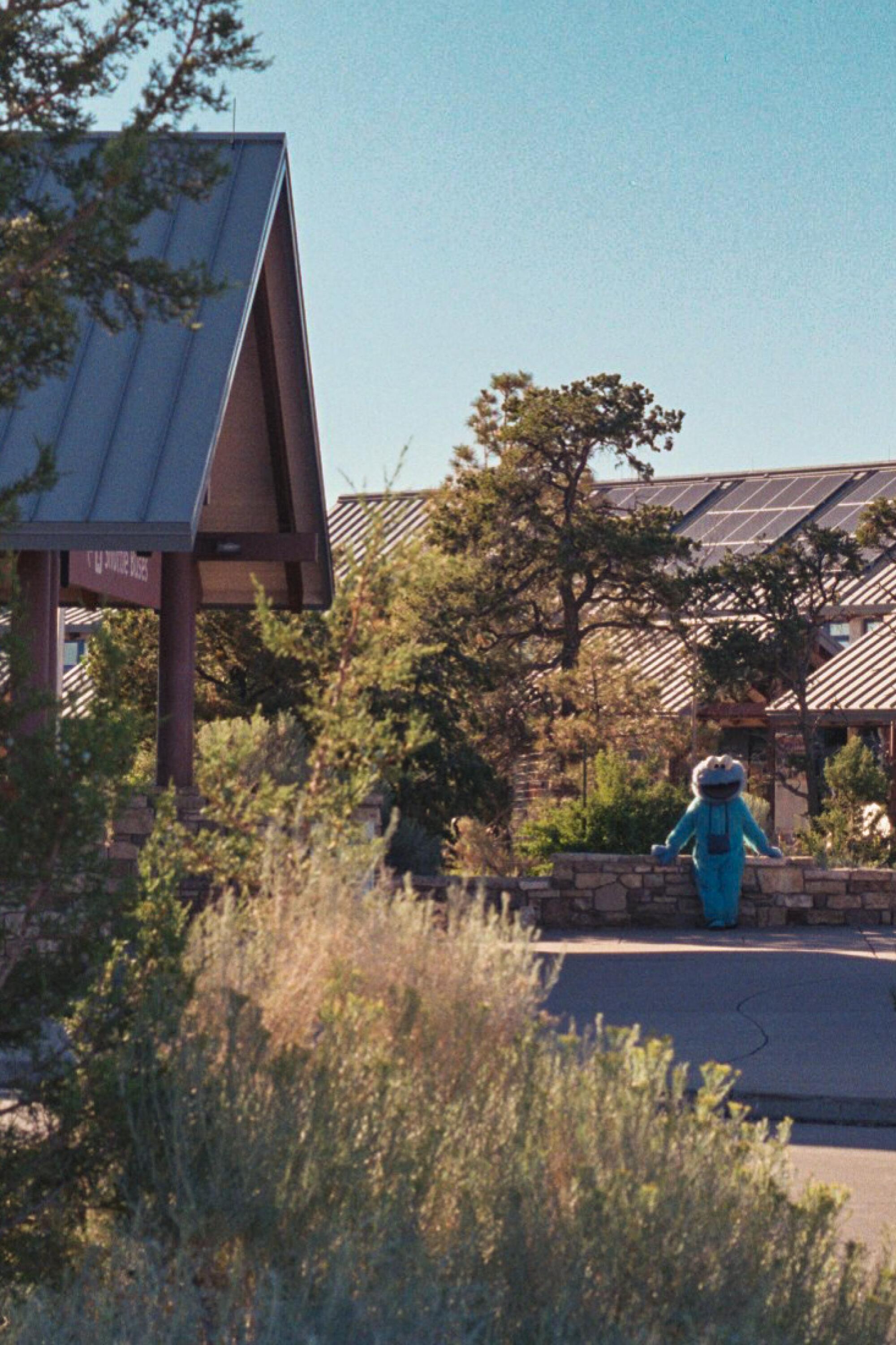
A lone Cookie Monster sitting outside of the Grand Canyon Visitor Center.
(Reanna Cruz)
But after the sun went down, we realized how vast the sky really is when it’s uninterrupted by light pollution. Elusive stars began to emerge, dappling the stretches of sky that often look empty between streaks of red and green aircraft lights and astronomical divas like the North Star or Big Dipper. Like many national parks, the Grand Canyon is an international dark sky park, which meant we were able to see the Milky Way hanging over our heads before the moon rose. As our eyes adjusted to the darkness, it brought me back to the elation of being at summer camp for the first time, where the air was filled with giddy crushes and late-night gossip. For the rest of the night, we earnestly reflected on our trip, which gave us so many magical opportunities to sample new lifestyles and states of being together.
To optimize our time gawking at the stars and cuddling on porch swings, we made a late-night dinner reservation at the El Tovar Dining Room, where the food was forgettable (like most national park fare). But we still had a silly time doing math problems on the children’s menu, ordering virgin prickly pear margaritas and sharing two delicious house-made desserts.
By this point, you could imagine the breakneck pace of driving from one rock-gazing spot to another — back to back to back — was proving to be a trial of the human spirit. But the next morning, we reluctantly got in the car to drive six more hours to Joshua Tree National Park, which was somehow our most exhausting day on the road. Though it wasn’t our longest stretch of driving, we were feeling extra tired, homesick and cramped by our rental car full of wares and stale snacks.
We broke up that stretch a bit by stopping in Seligman, Arizona, which was the birthplace of historic Route 66 and the inspiration for the Pixar movie “Cars.” After getting another burger at Delgadillo’s Snow Cap Drive-In — a restaurant where they’ll hand you a thimble-sized cup (with a straw cut to size) if you dare to order a small Coke — I paid a visit to Angel Delgadillo’s barber shop and bought a delightfully gaudy Route 66 button-down.
Back to California
Once we finally made it to the south entrance of Joshua Tree, we realized we should’ve booked a room closer to the north exit of the park instead of Palm Springs so we could enter one side and leave the other. (This is why I’d recommend you stay in Pioneertown if you chose to do this trip — don’t make the same mistakes I did!)
But after exploring Joshua Tree and paying visits to a few of our favorite jumbo rocks, we were more than excited to head to the Palm Springs Margaritaville, where we got to lounge in the pool, watch the movie “Cars” and order fish tacos and lava cake to our bed. If room service is a dying art, we are some of its most dedicated patrons.
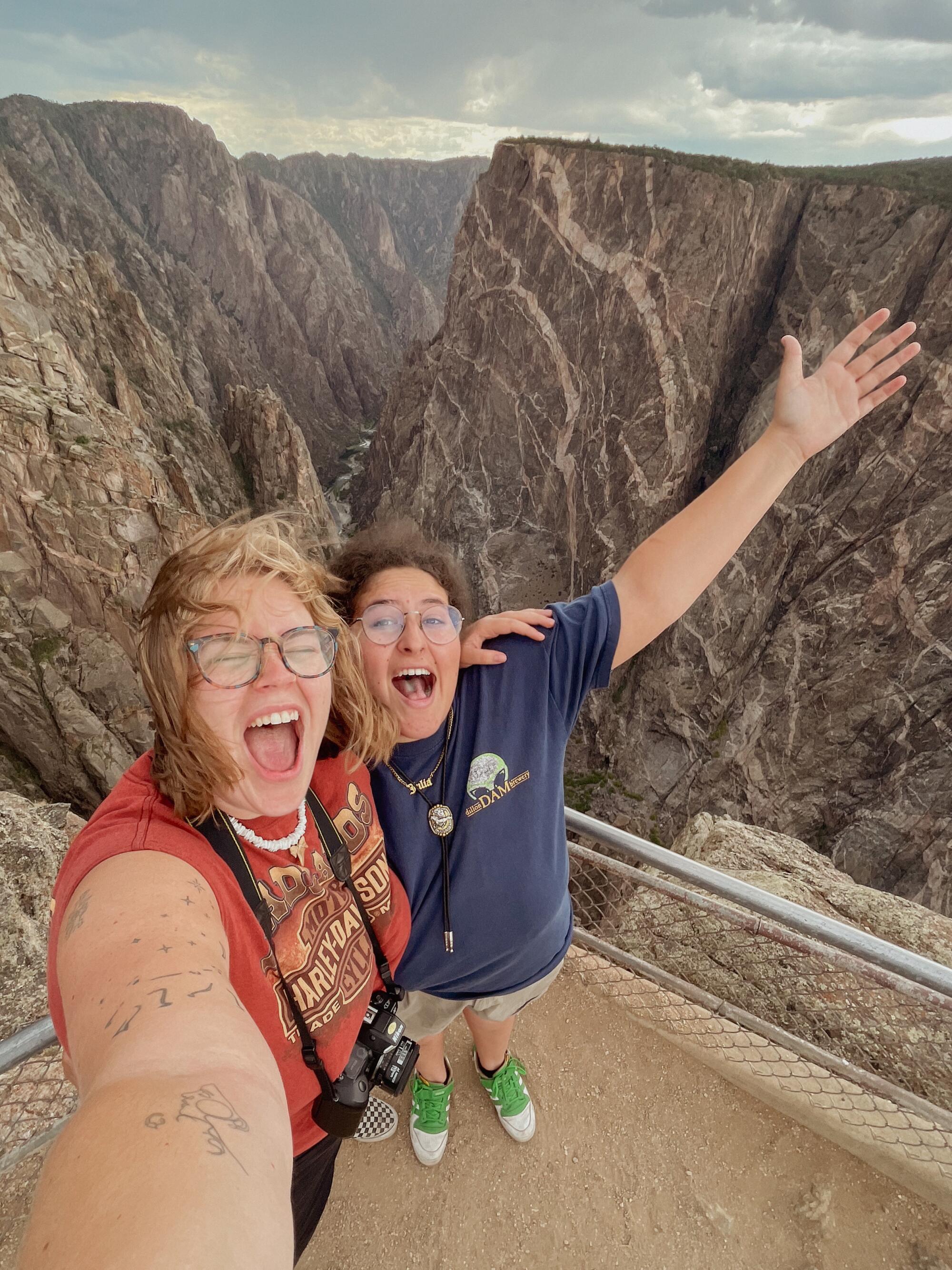
Julia and Reanna, reveling in the majesty of Colorado’s Black Canyon.
(Julia Carmel / Los Angeles Times)
The final day of driving (a mere three hours back to L.A.) felt like absolutely nothing compared to how far we had already traveled, and we relished having cell service and familiar roads at our disposal. After weeks of driving through different states at all hours of the day and night, Reanna even said that L.A. freeways felt like “driving on easy mode.”
And after throwing out a shameful amount of car trash, watering my plants and doing several loads of laundry, I was relieved to be home again. As some wise stranger on the internet once said, the best feelings in the world are always leaving L.A. and coming back to L.A.
For all the latest Life Style News Click Here
For the latest news and updates, follow us on Google News.
